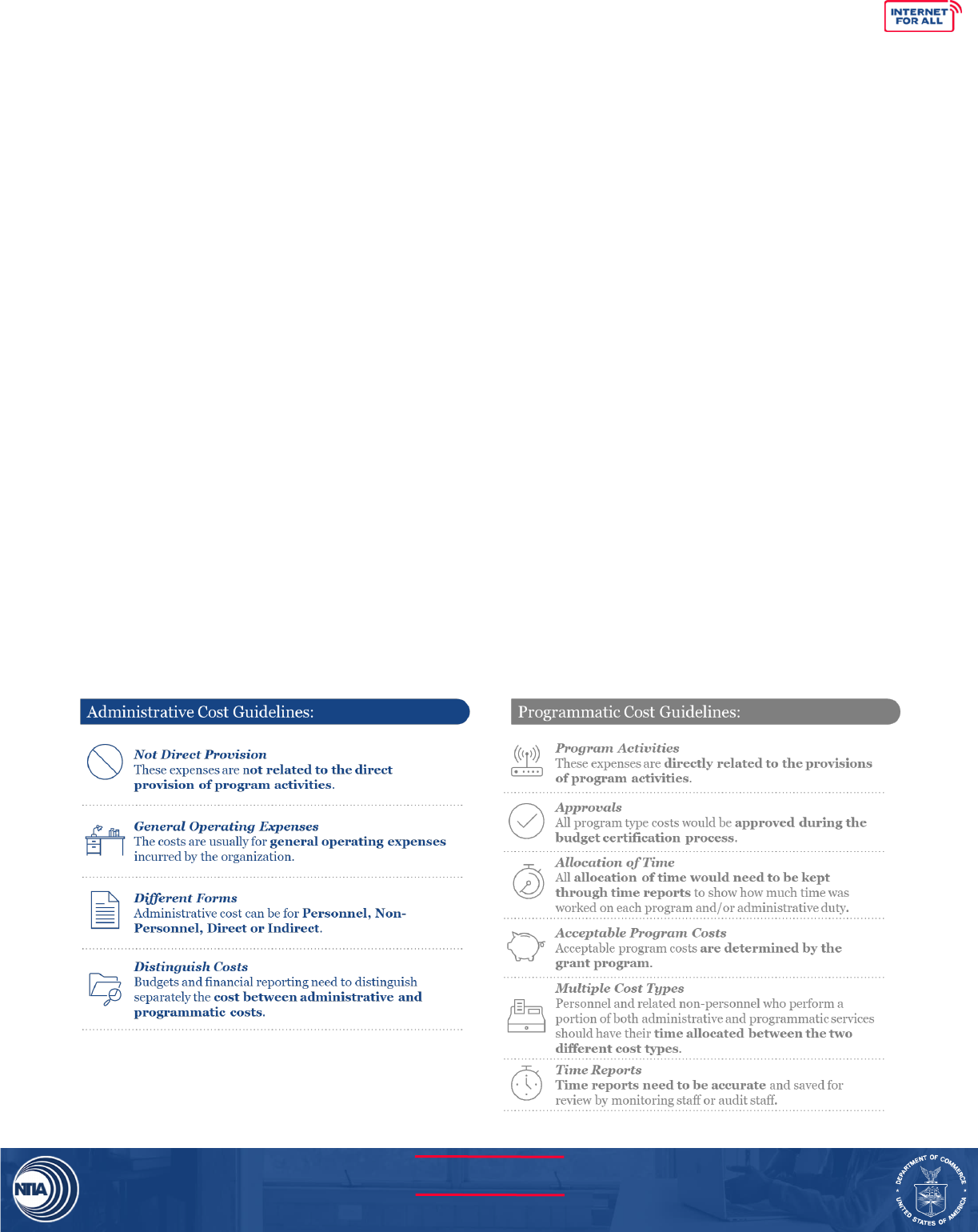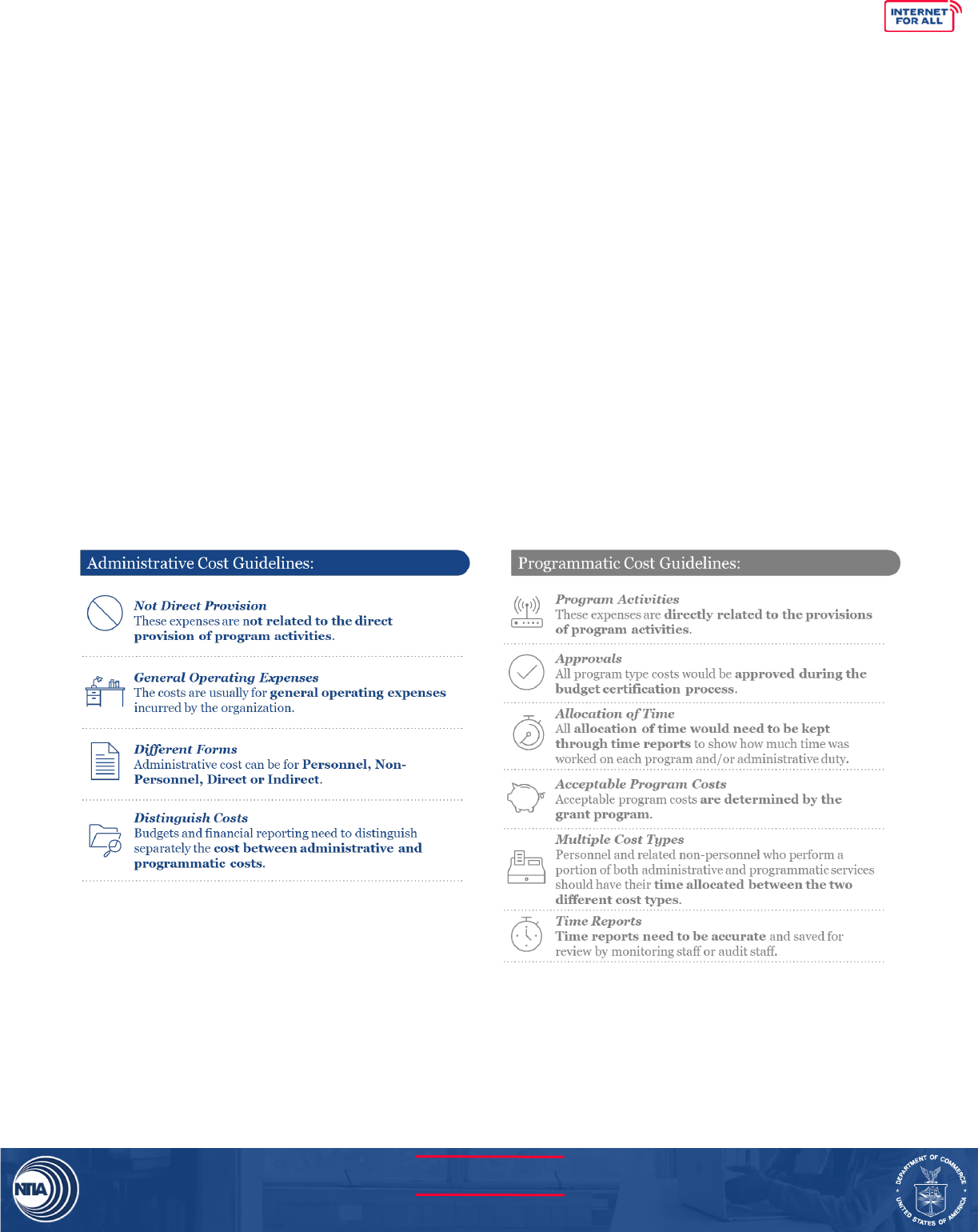
Frequently Asked Questions
and Answers Draft Version 2.0
Broadband, Equity, Access, and
Deployment (BEAD) Program
INTERNET FOR ALL
U.S. Department of Commerce
National Telecommunications and Information Administration

Page | 1
Internet for All
Note
The Broadband, Equity, Access & Deployment Program (BEAD)
1
provides federal funding to
make grants to Eligible Entities for broadband planning, deployment, mapping, equity, and
adoption projects and activities. The following Frequently Asked Questions (FAQs) are intended
to clarify and provide guidance on information set forth in the Notice of Funding Opportunity
(NOFO) on May 13, 2022. NTIA will update this document on a periodic basis as further
questions arise. Newly added questions in this FAQ are indicated with an asterisk (*). Questions
may be submitted to BEAD@ntia.gov.
The below FAQs are for informational purposes only and are intended solely to assist potential
applicants in better understanding the NTIA BEAD Program and the application requirements
set forth in the Notice of Funding Opportunity (NOFO) for this program. The FAQs do not and
are not intended to supersede, modify, or otherwise alter applicable statutory or regulatory
requirements, or the specific application requirements set forth in the NOFO. In all cases,
statutory and regulatory mandates, and the requirements set forth in the NOFO, shall prevail
over any inconsistencies contained in the below FAQs.
Please note that all new questions are disbursed throughout the document as well in their
appropriate sections. All new questions and answers are italicized.
1
Authorized by the Infrastructure Investment and Jobs Act of 2021, Division F, Title I, Section 60102,
Public Law 117-58, 135 Stat. 429 (November 15, 2021), also known as the Bipartisan Infrastructure Law.

Page | 2
Internet for All
Contents
1. Program Overview and Eligibility ........................................................................................... 3
2. Letter of Intent (LOI) Submission and Initial Planning Funds ............................................. 11
3. Local Coordination ................................................................................................................. 16
4. Mapping and Analytics .......................................................................................................... 20
5. Five-Year Action Plan ............................................................................................................ 24
6. Digital Equity ......................................................................................................................... 28
7. Funding and Allocation Process ............................................................................................ 29
8. Initial Proposal ...................................................................................................................... 37
9. Cost Sharing and Matching Guidelines ................................................................................. 42
10. Competitive Subgrantee Grants ......................................................................................... 46
11. Final Proposal .................................................................................................................... 50
12. Grant Award and Reporting Requirements ....................................................................... 53
13. Cross-Program .................................................................................................................... 57
Appendix: *New Questions & Answers as of Version 2.0 ............................................................ 59

Page | 3
Internet for All
1. Program Overview and Eligibility
1.1 Who can apply for funding under the BEAD program?
Any State of the U.S., the District of Columbia, Puerto Rico, American Samoa, Guam, the U.S.
Virgin Islands, and the Commonwealth of the Northern Mariana Islands are considered
“Eligible Entities” under the BEAD program and may apply for funding.
1.2 Can U.S. territories / the District of Columbia apply for funding under the
BEAD program?
Yes, BEAD funds are available for use by U.S. territories and the District of Columbia.
1.3 What are the eligible uses of general funds (i.e., funds not including planning
funds) for BEAD?
Subject to the prioritization scheme included in the NOFO, BEAD funds may be used for the
purposes listed below. A complete list of the eligible uses of funds is included in the NOFO at
Sections IV.B.7.a.(ii) and (iii).
1. Deploying and/or upgrading broadband network facilities in connection with an
Unserved Service Project or an Underserved Service Project;
2. Deploying and/or upgrading broadband network facilities to provide or improve service
to an eligible community anchor institution;
3. Data collection, broadband mapping, and planning to the extent necessary beyond the
planning fund allocation to facilitate the goals and deliverables of the BEAD Program;
4. Installing internet and Wi-Fi infrastructure or providing reduced-cost broadband within
a multi-family residential building, with priority given to a residential building that has
substantial share of unserved households or is in a location in which the percentage of
individuals with a household income that is at or below 150 percent of the poverty line
2
applicable to a family of the size involved is higher than the national percentage of such
individuals;
5. Broadband adoption, including programs to provide affordable internet-capable devices;
6. Training and workforce development; and
7. Other uses, including other Digital Equity programs not already included above,
proposed by Eligible Entities and approved in advance in writing by the Assistant
Secretary that support the goals of the Program.
3
2
As determined under Section 673(2) of the Community Services Block Grant Act (42 U.S.C. § 9902(2)).
3
Requests for approval of uses not listed here should be made in writing to the Assistant Secretary and
submitted through the appropriate Federal Program Officer. Eligible Entities should make such requests
on a timely basis to facilitate resolution prior to point at which the Eligible Entity seeks to make the
expenditure or expenditures at issue.

Page | 4
Internet for All
1.4 What are the core milestones for the BEAD program and what does an
Eligible Entity need to submit by when?
In creating the BEAD program, the Bipartisan Infrastructure Law created a multi-step, multi-
year process. NTIA will work as expeditiously as possible to effectively implement the program.
The chart below summarizes the key milestones of the BEAD Program and additional
information about program sequencing can be found in Section IV.B. of the NOFO:
Stage
Description
Letter of Intent
July 18, 2022, is the deadline for an Eligible Entity to submit a
Letter of Intent to participate in the Program.
Request for Initial
Planning Funds
A state, the District of Columbia, or Puerto Rico may request up to
$5,000,000 in Initial Planning Funds. American Samoa, Guam, the
U.S. Virgin Islands, and the Commonwealth of the Northern
Mariana Islands may request up to $1,250,000. Each Eligible
Entity’s Initial Planning Funds will be drawn from that Eligible
Entity’s Minimum Initial Allocation. If the Eligible Entity requests
Initial Planning Funds,
it must submit an application for Initial
Planning Funds by August 15, 2022, and a Five-Year Action Plan
within 270 days of receipt of Initial Planning Funds.
Notice of Available
Amounts
On or after the date on which the Broadband DATA Maps are made
public, the Assistant Secretary will notify each Eligible Entity of the
estimated amount of funding that NTIA will make available to the
Eligible Entity under the Program (Notice of Available Amounts)
and invite the submission of an initial grant proposal (Initial
Proposal) and a final grant proposal (Final Proposal).
Initial Proposal
Eligible Entities will have 180 days from receipt of the Notice of
Available Amounts to develop and submit an Initial Proposal, which
will, among other things, describe the competitive process the
Eligible Entity proposes to use to select subgrantees to construct
broadband projects. Prior to submission to NTIA, the Initial
Proposal must be made available for public comment and must
incorporate local coordination feedback for the Assistant Secretary’s
review.
Challenge Process
After submission of its Initial Proposal and before allocating BEAD
funds received for the deployment of broadband networks, an
Eligible Entity must conduct a challenge process. Under this
process, a unit of local government, nonprofit organization, or
broadband service provider can challenge a determination made by
the Eligible Entity in the Initial Proposal as to whether a particular
location or community anchor institution within the jurisdiction of
the Eligible Entity is eligible for the grant funds, including whether
a particular location is unserved or underserved, and submit any
successful challenges to NTIA for review and approval.
Initial Funding
Availability
NTIA will review Initial Proposals as expeditiously as possible.
Once an Initial Proposal is approved, NTIA will make available to
the Eligible Entity not less than 20 percent of the total grant funds
allocated to the Eligible Entity.
Subgrantee
Selection
An Eligible Entity may initiate its competitive subgrantee selection
process upon approval of its Initial Proposal and will have up to one
year to conduct additional local coordination, complete the selection

Page | 5
Internet for All
process, and submit a Final Proposal to NTIA. The Eligible Entity
may, at this point, utilize the funding provided upon approval of the
Initial Proposal (not less than 20 percent of the Eligible Entity’s
total grant funds) to initiate qualifying activities.
Final Proposal
After the Eligible Entity has selected subgrantees and otherwise
executed its approved Initial Proposal, it will submit to NTIA a Final
Proposal describing how it complied with that Initial Proposal and
the results of its processes. NTIA will award the remaining funds
allocated to the Eligible Entity upon approval of the Eligible Entity’s
Final Proposal, and Eligible Entities will initiate their subgrants for
the remaining 80 percent of funding and any portion of the original
20 percent that the Eligible Entity has not yet awarded as a
subgrant. Prior to submission to NTIA the Final Proposal must be
made available for public comment.
Ongoing
Monitoring,
Reporting, and
Performance
Management
Throughout the BEAD Program, NTIA will conduct ongoing
monitoring of an Eligible Entity’s progress against its plans and
ensure that the requirements of the Infrastructure Act are met.
Eligible Entities will be required to comply with reporting
requirements and monitor subgrantee compliance.
1.5 How does the BEAD program define an “unserved” location?
An unserved service project is defined as a project in which not less than 80 percent of
broadband-serviceable locations served by the project are unserved locations. An “Unserved
Service Project” may be as small as a single unserved broadband serviceable location (NOFO
Section I.C.ee).
An unserved location is defined as a broadband-serviceable location that the Broadband DATA
Maps show as (a) having no access to broadband service, or (b) lacking access to Reliable
Broadband Service offered with - (i) a speed of not less than 25 Mbps for downloads; and (ii) a
speed of not less than 3 Mbps for uploads; and (iii) latency less than or equal to 100 milliseconds
(NOFO Section I.C.dd).
1.6 How does the BEAD program define an “underserved” location?
An underserved service project is defined as a project in which not less than 80 percent of
broadband-serviceable locations served by the project are unserved locations or underserved
locations. An “Underserved Service Project” may be as small as a single underserved broadband-
serviceable location (NOFO Section I.C.cc).
An underserved location is defined as a broadband-serviceable location that is (a) not an
unserved location, and (b) that the Broadband DATA Maps show as lacking access to Reliable
Broadband Service offered with - (i) a speed of not less than 100 Mbps for downloads; and (ii) a
speed of not less than 20 Mbps for uploads; and (iii) latency less than or equal to 100
milliseconds (NOFO Section I.C.bb).
1.7 How does the BEAD program define a “Community Anchor Institution”
(CAI)?

Page | 6
Internet for All
Section I.C.f. of the NOFO defines “Community Anchor Institution” as an entity such as a
school, library, health clinic, health center, hospital or other medical provider, public safety
entity, institution of higher education, public housing organization, or community support
organization that facilitates greater use of broadband service by vulnerable populations,
including, but not limited to, low-income individuals, unemployed individuals, children, the
incarcerated, and aged individuals. An Eligible Entity may propose to NTIA that additional types
of institutions should qualify as CAIs within the entity’s territory.
1.8 Which Community Anchor Institutions are eligible to receive broadband
access through the BEAD Program?
A Community Anchor Institution that lacks access to Gigabit-level broadband service is an
eligible service location under the BEAD Program.
1.9 Are BEAD funds only restricted for use on last-mile broadband deployment?
May funds be used for middle mile infrastructure?
As noted in Section IV.B.5.b. of the NOFO an “Unserved Service Project” or “Underserved
Service Project” may include Middle Mile Infrastructure in or through any area required to
reach interconnection points or otherwise to ensure the technical feasibility and financial
sustainability of a project providing service to an unserved location, underserved location, or
eligible CAI.
1.10 How must an Eligible Entity prioritize eligible uses of BEAD funding?
In general, Eligible Entities must follow the process below in prioritizing eligible uses of BEAD
funding as explained in Section IV.B.7.b. of the NOFO:
1. An Eligible Entity must prioritize deploying broadband service to unserved service
projects. With respect to those deployments, the Eligible Entity should prioritize
projects designed to provide fiber connectivity directly to the end user. The Eligible
Entity should also prioritize proposals that provide affordable service to end users,
minimize the program subsidy required, and demonstrated record of and plans to
follow Federal labor and employment laws, speed of deployment, and speed of the
proposed network. Eligible Entities may also consider other factors that align with
state and local priorities. This can include deploying Wi-Fi to multiunit buildings that
are currently unserved.
2. Once an Eligible Entity certifies that it will reach all unserved locations in its
jurisdiction, the Eligible Entity must next prioritize the provision of broadband to
underserved service projects, again prioritizing fiber services and the other criteria
mentioned above.
3. To the extent an Eligible Entity has funds left over after allocating funds for unserved
and underserved areas, it can then use funds to connect and upgrade community
anchor institutions such as libraries and community centers that lack a 1 gigabit per
second (Gbps) connection or to pursue eligible access-, adoption-, and equity-related
uses, as well as any other uses approved by the Assistant Secretary that support the
Program’s goals.

Page | 7
Internet for All
Please note that these requirements do not impose any temporal requirement as to the order in
which BEAD-funded initiatives are undertaken or completed. NTIA recognizes that broadband
deployment projects often take months or years to complete, whereas certain other eligible uses
of BEAD funds can be implemented more quickly. Thus, if an Eligible Entity has a plan to deploy
service to all unserved and underserved locations within its jurisdiction, it may pursue non-
deployment initiatives using BEAD funds before or while deployment projects are underway.
For example, while an Eligible Entity is only permitted to pursue a device-subsidy program
using BEAD funds if it has a plan to deploy service to all unserved and underserved locations
within its jurisdiction, an Eligible Entity proposing such a program is both permitted and
encouraged to implement it as soon as is feasible once its Initial Proposal has been approved.
1.11 Who can an Eligible Entity designate to administer the BEAD program?
An Eligible Entity may designate any entity within the state or territorial government (i.e., state
department, agency, or office) to administer the BEAD program, so long as this entity is able to
meet program requirements, including administration of a competitive subgrant process. An
Eligible Entity may create and designate a new or standalone entity to administer the program if
desired.
1.12 Is an Eligible Entity able to change the administering entity for the BEAD
program after initial designation in the LOI?
Yes. An Eligible Entity may contact its Federal Program Officer or other designated program
contact to change the designated administering entity or the point-of-contact. Eligible Entities
must provide updates to Federal Program Officers of any personnel changes that result in
changes to the designated point-of-contact.
1.13 Can an Eligible Entity designate more than one entity to administer the
program?
An Eligible Entity must designate a lead entity for BEAD program administration in the LOI, but
an Eligible Entity may distribute program administration responsibilities among multiple
entities if desired.
1.14 Must the same entity administer both the Digital Equity Act and the BEAD
program?
No. The same entity is not required to administer both the BEAD Program and the Digital
Equity Act Planning and Capacity Grants. However, Eligible Entities are strongly encouraged to
ensure collaboration between these initiatives to create a cohesive effort to close the digital
divide with the Eligible Entity. This will be important in reducing the burden and confusion on
community stakeholders when fulfilling the local coordination requirements in the NOFO and
building an inclusive plan for the Eligible Entity.
1.15 Are public health institutions considered an Eligible Entity as a subgrant
recipient?*
Eligible Entities may not exclude cooperatives, nonprofit organizations, public-private
partnerships, private companies, public or private utilities, public utility districts, or local
governments (“potential providers”) from eligibility for grant funds (NOFO Section IV.C.1.a).

Page | 8
Internet for All
To the extent that a “public health institution” falls into one of those categories, it is eligible to
be a subgrant recipient.
1.16 Will BEAD cover both capital expenditures (CapEx) and operating
expenditures (OpEx)?*
The BEAD Program does not restrict eligible uses of funds to capital expenses. However, the
cost principals applied must be in accordance with 2 C.F.R. Part 200, Subpart E for States and
non-profit organizations and in 48 C.F.R. Part 31 for commercial organizations.
Refer to section IV.B.2 of the NOFO for a listing of eligible uses of Initial Planning Funds,
Section IV.B.5.b. for how funds can be allocated for the Initial Proposal, and sections IV.B.7.a.ii
and IV.B.7.a.iii for eligible use of funds for last-mile broadband Deployment and non-
Deployment activities.
An Eligible Entity may not use more than two percent of the grant amounts received under the
BEAD Program for expenses relating (directly or indirectly) to administration of the grant under
Section 60102(d)(2)(B) of the Infrastructure Act.
In addition, requests for approval of uses of funds not listed should be made in writing to the
Assistant Secretary and submitted through the appropriate Federal Program Officer (FPO).
Eligible Entities should make such requests on a timely basis to facilitate resolution prior to the
point at which the Eligible Entity seeks to make the expenditure or expenditures at issue.
1.17 How long do Eligible Entities have to spend Initial Planning Funds?*
The period of performance for the planning grants will be 5 years from the date of award.
Eligible Entities can spend initial planning funds over the 5-year period.
1.18 Is an area that has no fiber but is served by fixed wireless at speeds of 100/20
considered served or unserved?*
Under the BEAD Program, any location with speeds of 100/20 by technology that meets the
definition of Reliable Broadband Service is considered served. Reliable Broadband Service is
broadband service that the FCC Broadband DATA Maps show is accessible to a location via: (i)
fiber-optic technology; (ii) Cable Modem/ Hybrid fiber-coaxial technology; (iii) digital
subscriber line (DSL) technology; or (iv) terrestrial fixed wireless technology utilizing entirely
licensed spectrum or using a hybrid of licensed and unlicensed spectrum (NOFO Section I.C.u).
Eligible Entities will establish an Extremely High Cost Per Location Threshold above which an
Eligible Entity may decline to select a proposal if use of an alternative technology meeting the
BEAD Program’s technical requirements would be less expensive. Eligible Entities must
establish its Extremely High Cost Per Location Threshold in a manner that maximizes use of the
best available technology while ensuring that the program can meet the prioritization and
scoring requirements set forth in Section IV.B.7.b of the BEAD NOFO. NTIA expects Eligible
Entities to set the Extremely High Cost Per Location Threshold as high as possible to help
ensure that end-to-end fiber projects are deployed wherever feasible.
1.19 Are Eligible Entities or subgrantees subject to any union requirements?*
Quality, high paying jobs, a skilled workforce, and safe workplaces are critically important to the
overall goals of the BEAD Program. However, a union workforce is not required. If a subgrantee

Page | 9
Internet for All
does not utilize union labor or pay at or above the prevailing wage, the wages paid to staff must
be reported (NOFO Section VII.E.2).
1.20 Are subgrantees required to retain ownership of assets that they build, or can
ownership be transferred in exchange for arrangements like right of way?*
The costs related to the assets are only allowed to be charged to the grant if they are necessary
and reasonable for the performance of the BEAD award. As these assets would not be used in
the performance of the BEAD award, they are not necessary and reasonable for the purpose of
this grant and are thus not allowed (see 2 CFR 200.403(a)). The costs related to a plan to build
grant-funded assets for eventual exchange, for example exchanging asset ownership for right of
way, are not allowable. If a subgrantee sought to obtain a right of way using NTIA grant funds,
and the costs related to obtaining that right of way were determined to be necessary and
reasonable for the purpose of the grant, those costs would be an allowable use of NTIA grant
funds.
In the event that original or replacement grant-funded equipment is no longer needed for the
original project or program, the Eligible Entity and subrecipients must dispose of property in
accordance with 2 CFR 200.313.
1.21 Are Tribal Entities eligible to apply for BEAD Program funding?*
Tribal Entities are not Eligible Entities under the BEAD Program. However, Tribal entities can
apply to be a subgrantee through the Eligible Entity’s (the state’s or territory's) Grants Office.
Additionally, states are required to have formal Tribal consultations with Tribal Entities as part
of their BEAD planning. Contact information for state broadband offices can be found at
broadbandusa.ntia.doc.gov/resources/states,
1.22 How do Tribal Entities pursue a subgrant?*
Tribal Entities can apply to be a subgrantee through their respective Eligible Entity’s (their
state’s or territory's) Grant Office. Tribal Entities are encouraged to engage with Eligible
Entities, beginning with the planning process and extending through the implementation of the
program.
1.23 If a provider has a demonstrated relationship with a subcontractor, is it
permissible to pursue a subcontract without obtaining three (3) competitive
quotes?*
Eligible Entities should keep in mind that there is a distinction between a subcontract and a
subgrantee/subrecipient. A subgrantee or subrecipient is an entity that receives grant funds
from an Eligible Entity (state, territory or the District of Columbia) to carry out eligible
activities. A contractor is an entity that receives a contract for the purpose of obtaining goods
and services for a non-Federal entity's own use (See 2 CFR § 200.331 for additional information
on subrecipient and contractor determinations).
When Eligible Entities are entering into a subcontracting relationship, they must follow their
own local procurement policies and procedures, including any competitive procurement
process. When Eligible Entities (states, territories, or the District of Columbia) enter into a
subgrant or subrecipient relationship to build broadband infrastructure, Eligible Entities must
establish a fair, open, and competitive process for selecting subgrantees (NOFO Section IV.B.7).

Page | 10
Internet for All
Eligible Entities that receive grants from the BEAD Program must satisfy the standards
established by the relevant NOFO, the Department’s Standard Terms and Conditions for federal
financial assistance awards, and 2 CFR Part 200. Under 2 CFR § 200.317, all subrecipients must
follow the procurement standards set forth in 2 CFR §§ 200.318 – 200.327.
1.24 Will subgrantees be allowed to deploy other offerings over a Funded
Network?*
Yes, subgrantees may use BEAD-funded facilities to provide other offerings, such as telephone
and video, over a Funded Network. It is important to note that income generated by a project
over the period of performance is subject to project income regulations outlined in 2 CFR §
200.307.
1.25 Is it permissible for broadband providers to use BEAD funding to serve
unserved locations within a different provider’s service area?*
Yes, if those areas are unserved or underserved locations.
1.26 Who holds the title to BEAD funded assets at the end of the period of
performance?*
Eligible Entities or subgrantees (when funding through a subgrant) will hold the title to BEAD
funded assets. All assets, however, are subject to federal interest per 2 CFR § 200 Subpart D,
the DOC Standard Terms and Conditions, and Specific Award Conditions.

Page | 11
Internet for All
2. Letter of Intent (LOI) Submission and Initial Planning
Funds
2.1 Who can apply for funding under the BEAD program?
Any State of the U.S., the District of Columbia, Puerto Rico, American Samoa, Guam, the U.S.
Virgin Islands, and the Commonwealth of the Northern Mariana Islands are considered
“Eligible Entities
2.2 When is the LOI due, and where must it be submitted?
The LOI is due by 11:59 pm EDT on July 18, 2022. The LOI must be submitted through the
NTIA Grants Portal at grants.ntia.gov. Additional information about LOIs can be found in
Section IV.B.1. of the NOFO.
2.3 Who can an Eligible Entity contact if it is having difficulty navigating the NTIA
Grants Portal?
If an Eligible Entity has questions related to the NTIA Grants Portal, they can contact
ngphelpdesk@ntia.gov.
2.4 Can an Eligible Entity edit its LOI once it has been submitted?
Edits may not be made to the LOI after submission. However, if an Eligible Entity needs to
change the administering entity or point-of-contact, the Federal Program Officer or other
assigned contact can assist in updating this information.
2.5 What are the necessary form and contents of the LOI?
The LOI should be in letter form and signed by the Governor of the Eligible Entity, or an
equivalent official (e.g., the Mayor of the District of Columbia). The LOI must include:
1. A statement that the entity intends to participate in the Program;
2. Identification of the agency, department, or office that will serve as the recipient of, and
administering agent for, any BEAD Program award for the Eligible Entity and the main
point of contact at that agency, department, or office for the purposes of the BEAD
Program;
Additionally, if the Eligible Entity wishes to receive planning funds, the LOI can include
a request for Initial Planning Funds. The Eligible Entity may also submit a request for
Initial Planning Funds and associated documentation later through the NTIA Grants
Portal.
For the planning funds to be released, Eligible Entities must complete the planning fund
application within the NTIA Grants Portal by August 15, 2022.
Eligible Entities are encouraged to use the provided LOI Template provided with the
Application Guidance. Additional information about LOIs can be found in Section
IV.B.1. of the NOFO.

Page | 12
Internet for All
2.6 Who can be listed as a Point of Contact in the LOI?
The main “Point of Contact” may be any individual coordinating the implementation of the
BEAD program within the administering agency, department, or office of the Eligible Entity.
This individual should be the person with line responsibility for programmatic operations.
2.7 How do I know if my state has submitted a Letter of Intent?
Visit internetforall.gov to see which states have submitted a Letter of Intent.
2.8 What if an Eligible Entity does not submit a LOI to participate in the BEAD
Program?
As explained in Section IV.B.10. of the NOFO, if an Eligible Entity does not submit an LOI
before the deadline (and no extension is granted), then a political subdivision or a consortium of
political subdivisions of the Eligible Entity may apply by submitting an LOI instead. In this case,
NTIA will publish a public notice inviting political subdivisions to apply. The public notice will
include any relevant deadlines and instructions for application submission.
2.9 If an Eligible Entity submits an LOI, do they automatically receive Initial
Planning Funds? If not, how does an Eligible Entity request Initial Planning
Funds?
No, an Eligible Entity will not automatically receive Initial Planning Funds by submitting an
LOI. An Eligible Entity must request Initial Planning Funds in the NTIA Grants Portal (NGP) by
submitting a planning application. The application can be submitted beginning immediately
following submission of the Letter of Intent up until August 15, 2022. As a part of the
application, an Eligible Entity will be required to submit the following information:
1. Standard organization information (i.e., AOR, Technical/Program POC);
2. Detail on eligible planning activities that the Eligible Entity plans to fund using the
Initial Planning Funds;
3. A brief narrative (1000 words maximum) describing activities to be completed using
the planning money;
4. SF 424, (i.e., application for federal assistance);
5. SF 424-C (i.e., budget information for construction programs)
6. SF-LLL (i.e., disclosure of lobbying activities);
7. CD-511 (i.e., certification of lobbying activities);
8. A detailed budget; and
9. A budget narrative.
Further detail and instruction on the above components are available in the application
guidance, which can be found on internetforall.gov, and in Section V of the NOFO.

Page | 13
Internet for All
2.10 If an Eligible Entity chooses not to request Initial Planning Funds in the LOI,
are they able to request the Funds at a later date?
Yes, until August 15, 2022. An Eligible Entity can re-enter the Grants Portal at any time until the
deadline to request Initial Planning Funds and submit the required application materials.
2.11 If an Eligible Entity requests Initial Planning Funds within its LOI, does the
Eligible Entity need to submit all the required application materials for the
funds at the same time?
No, an Eligible Entity does not need to submit all application materials at the time of LOI
submission. They can re-enter the Grants Portal at any time until August 15, 2022, to submit the
required application materials.
2.12 How much funding can an Eligible Entity request in Initial Planning Funds?
U.S. States, the District of Columbia, and Puerto Rico may request up to $5,000,000 in Initial
Planning Funds. American Samoa, Guam, the U.S. Virgin Islands, and the Commonwealth of the
Northern Mariana Islands may request up to $1,250,000 in Initial Planning Funds.
2.13 What happens to the Initial Planning Funding designated for an Eligible
Entity if that Entity does not request planning funding or requests less than
the maximum amount of planning funding?
Initial Planning Funds are part of the Minimum Total Allocation that each Eligible Entity will
receive. If an Eligible Entity does not request planning funds, those funds will be available to
the entity upon approval of the Initial and Final Proposals for broadband deployment and other
authorized uses. If an Eligible Entity requests less than the maximum amount of planning
funds, the remaining funds will be available as part of the Minimum Allocation released upon
approval and of the Initial and Final Proposals. Any Eligible Entity that does not request
planning funds or requests less than the maximum amount of planning funds will have those
funds for implementation. However, Eligible Entities that do not participate in the planning
process will not receive access to any funds prior to the approval of the Initial Proposal.
Additional information about the funding allocation process can be found in Section IV.B.4.c. of
the NOFO.
2.14 When and how will Initial Planning Funds be released?
NTIA will review LOI submissions for completeness, evaluate the application for Initial
Planning Funds, and award Initial Planning Funds as expeditiously as possible. As explained in
Section VI.C. of the NOFO, applications will be reviewed on a rolling basis. Eligible Entities are
encouraged to submit their applications as soon as possible.
2.15 Are there any conditions to receiving Initial Planning Funds?
Eligible Entities that receive Initial Planning Funds are required to submit a Five-Year Action
Plan within 270 days of the receipt of funds. Eligible Entities must also comply with all
programmatic and grant requirements included in the NOFO.
2.16 How may an Eligible Entity use the Initial Planning Funds?

Page | 14
Internet for All
Initial Planning Funds may be used for the following planning and pre-deployment activities:
1. Research and data collection, including initial identification of unserved locations
and underserved locations;
2. The development of a preliminary budget for pre-planning activities;
3. Publications, outreach, and communications support;
4. Providing technical assistance to potential subgrantees, including through workshops
and events;
5. Training for employees of the broadband program or office of the Eligible Entity, or
employees or political subdivisions of the Eligible Entity, and related staffing
capacity or consulting or contract support to effectuate the goals of the BEAD
Program;
6. Establishing, operating, or increasing capacity of a broadband office that oversees
broadband programs and broadband deployment in an Eligible Entity;
7. Asset mapping across the Eligible Entity to catalogue broadband adoption,
affordability, equity, access and deployment activities occurring within the Eligible
Entity;
8. Conducting surveys of unserved, underserved, and underrepresented communities to
better understand barriers to adoption;
9. Costs associated with meeting the local coordination requirements in Section IV.C.1.c
of this NOFO including capacity building at the local and regional levels or contract
support;
10. Reasonable post-NOFO, pre-award expenses in an amount not to exceed $100,000
relating to the preparation of program submissions to NTIA (such as the LOI) or
adding additional capacity to state or territorial broadband offices in preparation for
the BEAD Program may be reimbursed if they are incurred after the publication date
(May 13, 2022) of this NOFO and prior to the date of issuance of the grant award
from NTIA, except that lobbying costs and contingency fees are not reimbursable
from grant funds. Pre-award expenses should be clearly identified in the proposed
project budget. Additionally, pre-award costs are incurred at the sole risk of the
applicant and will not be reimbursed by NTIA if the proposed project does not
receive an award pursuant to this Program. Pre-award expenses must be approved
by NTIA and the Grants Officer in writing to be considered allowable; and
11. Other uses approved in advance writing by the Assistant Secretary (including in
response to an Eligible Entity’s request) that support the goals of the Program.
4
4
Requests for approval of uses not listed here should be made in writing to the Assistant Secretary and
submitted through the appropriate Federal Program Officer. An Eligible Entity should make such
requests on a timely basis to facilitate resolution before the Eligible Entity seeks to make the expenditure
or expenditures at issue.

Page | 15
Internet for All
If an Eligible Entity requests and receives Initial Planning Funds, it will be required to submit a
Five-Year Action Plan. Eligible Entities should reserve enough resources to complete the plan in
a timely manner. Additional information about requesting Initial Planning Funds can be found
in Section IV.B.2. of the NOFO.
2.17 Can an Eligible Entity use Initial Planning Funds to hire additional full time
employees or increase the capacity of its broadband office or program?
Yes, these are eligible uses of BEAD funds as noted in Section IV.B.2. of the NOFO.
2.18 Can an Eligible Entity subgrant planning funds to local governments?
Yes, an Eligible Entity can make subgrants to local governments to carry out eligible activities
for the Initial Planning Funds.
2.19 How may BEAD Initial Planning Funds be used in conjunction with other
federal funding (e.g., Capital Projects Fund, DEA) allocated to an Eligible
Entity?
Designated entities may use funds for eligible purposes as described in Section IV.B.2. of the
NOFO, but entities may not seek reimbursement for the same cost from different funding
sources. For example, one half of a staff member’s salary may be paid for through BEAD and one
half may be paid for through DEA, but the full staff member’s salary may not be paid for through
BEAD and DEA because then the federal government would be paying for the same cost twice.
2.20 If an Eligible Entity has incurred planning costs prior to receiving a planning
grant, may these costs be reimbursed once Initial Planning Funds are
released?
As described in Section IV.B.2. of the NOFO, BEAD funds may only be used to cover allowable
costs incurred during the period of performance, except for reasonable pre-award expenses not
exceeding $100,000 relating to the preparation of program submissions to NTIA (such as the
LOI and planning funds application) or adding capacity to a broadband office in preparation for
the BEAD Program. Reasonable pre-award expenses must be incurred after the publication date
(May 13, 2022) of this NOFO and prior to the date of issuance of the grant award from NTIA.

Page | 16
Internet for All
3. Local Coordination
3.1 What are the BEAD requirements for local coordination?
Each Eligible Entity is required to demonstrate coordination and collaboration with local,
regional, and Tribal (as applicable) entities (governmental and non-governmental) and diverse
stakeholder groups, including political subdivisions and local and community-based
organizations, to ensure full representation and inclusion of unserved, underserved, and
underrepresented communities throughout the planning and deployment process. This local
coordination must begin in the development of the Five-Year Action Plan and continue
throughout the entirety of the program. NTIA will evaluate the sufficiency of local coordination
efforts to ensure that each Eligible Entity activities include the following as further explained in
Section IV.C.1.c. of the NOFO:
1. Full geographic coverage of the Eligible Entity;
2. Meaningful engagement and outreach to diverse stakeholder groups and community
organizations;
3. Utilization of multiple awareness and participation mechanisms and different
methods to convey information and outreach;
4. Transparency of processes to include the documentation and publication of results
and outcomes of coordination and outreach efforts, including related additions or
changes to the Initial Proposal and/or Final Proposal (e.g., documentation of
responses to comments received from local stakeholders); and
5. Outreach to and direct engagement of unserved and underserved communities to
include historically underrepresented and marginalized groups and/or communities.
3.2 Why is local coordination important?
Local coordination and stakeholder engagement is critical to the BEAD Program’s success, to
eliminating barriers to broadband access and adoption, and to rapidly and economically
building out new broadband networks. NTIA views strong involvement between Eligible Entities
and local communities as key to ensuring that the broadband needs of all unserved and
underserved locations and underrepresented communities are accounted for in Initial and Final
Plans. Local coordination promotes alignment of priorities between the Eligible Entity and local
officials and helps ensure visibility of local needs and preferences. Robust engagement efforts
increase initial adoption rates once the broadband is deployed and stimulate awareness about
the programs that can support the local community.
3.3 What must an Eligible Entity do to demonstrate that it has met the requisite
level of local coordination in its Five-Year Plan and throughout the BEAD
program?
An Eligible Entity is required to document local coordination and outreach activities by
providing a detailed description of its efforts to engage local governments, community groups,
underrepresented populations, and other stakeholders in the Five-Year Action Plan, Initial
Proposal, and Final Proposal, relative to each stage in the BEAD program process. NTIA will

Page | 17
Internet for All
consider quantitative measures as well as the quality of the engagements as noted in Section
IV.C.1.c. of the NOFO.
3.4 How may localities, tribes, and other stakeholders become involved in the
BEAD program?
Localities, tribes, and other stakeholders should reach out to and establish communication with
their state broadband offices. Entities may connect with their state office by looking up state
contacts through the State Broadband Leaders Network (SBLN) at this link, reaching out to
NTIA to make a connection, or reaching out to state and county municipal associations.
Stakeholders may consider assessing previous stakeholder engagement efforts, sharing feedback
with states and localities on engagement processes, and communicating opportunities for local
involvement and collaboration.
Localities can play a key role in:
a. Understanding community needs, priorities, and current broadband projects;
b. Engaging with underrepresented populations to ensure all voices are heard; and
c. Communicating local insights to the Eligible Entity.
3.5 How will NTIA monitor whether states are indeed engaging with key
stakeholders as required?*
For BEAD, each Eligible Entity must ensure that a diverse set of stakeholders is involved in
development of its Five-Year Action Plan, Initial Proposal, and Final Proposal. The Final
Proposal requires the Eligible Entity to provide a certification that it has conducted
coordination, including with Tribal Governments, local community organizations, and unions
and worker organizations, consistent with the requirements set forth in the BEAD NOFO and
include a description of the coordination conducted, and a summary of the impact such
coordination had on the content of the Final Proposal (NOFO Section IV.C.1.c). For Digital
Equity, Eligible Entities must include stakeholder engagement in Digital Equity plan,
implementation strategy, and their coordination and outreach strategy. States and Territories
must establish coordinate and collaborate with ongoing engagement representatives of each
category of covered populations within the State and with the full range of stakeholders within
the State (NOFO Section IV.C.4.b.i).
When conducting local coordination and outreach activities, Eligible Entities must establish,
document, and adhere to clear procedures to ensure transparency. This includes publicly
posting the proposals prior to submission to NTIA as well as plans or comments submitted by
local political subdivisions or Tribal Governments and explanations of how local
recommendations were addressed. Examples of ways to promote and document transparency
include but are not limited to publicly available information and easily navigable websites with
up-to-date information, periodic reporting/reports to local and community stakeholders, and
involvement of diverse stakeholders in the planning, implementation and execution of
coordination and outreach efforts and activities, and in-person meetings and mailings.
NTIA will also have FPO in place as state NTIA liaisons to provide support and technical
assistance, and to ensure that the Final Proposal fully meets the requirements of the
Infrastructure Act and the goals of the program.

Page | 18
Internet for All
3.6 Can planning funds be expended for consulting services to support
stakeholder outreach and plan development?*
Yes, Planning Funds may be used for planning and pre-deployment activities to include training
for employees of the broadband program or office of the Eligible Entity or employees of political
subdivisions of the Eligible Entity, and related staffing capacity or consulting or contracted
support to effectuate the goals of the BEAD Program (NOFO Section IV.B.2).
This section of the NOFO also states that funds can be used for other uses approved in advance
in writing by the Assistant Secretary (including in response to an Eligible Entity’s request) that
support the goals of the Program.
3.7 What are the differences between the local coordination requirements for
BEAD and the Digital Equity Act? Should an eligible entity organize one local
coordination effort that meets the requirements of both programs?*
Yes. In fact, NTIA strongly encourages Eligible Entities to conduct BEAD and Digital Equity
Program local coordination efforts in tandem as one cohesive effort, especially because BEAD
and the State Digital Equity Planning Grant Program are very closely aligned. Specifically, NTIA
expects that the Five-Year Action Plans and Initial Proposals developed for the BEAD Program
will fully incorporate the Digital Equity Plans developed for the State Digital Equity Planning
Grant Program.
See Section I.B. of the State Digital Equity Planning Grant Program NOFO and Section IV.C.1.c.
of the BEAD NOFO for more information.
BEAD Local
Coordination
Requirements
Local coordination efforts include the following as further explained in
Section IV.C.1.c. of the BEAD NOFO:
1. Full geographic coverage of the Eligible Entity
2. Meaningful engagement and outreach to diverse stakeholder groups and
community organizations
3. Utilization of multiple awareness and participation mechanisms and
different methods to convey information and outreach
4. Transparency of processes to include the documentation and publication
of results and outcomes of coordination and outreach efforts, including
related additions or changes to the Initial Proposal and/or Final Proposal
(e.g., documentation of responses to comments received from local
stakeholders)
5. Outreach to and direct engagement of unserved and underserved
communities to include historically underrepresented and marginalized
groups and/or communities.

Page | 19
Internet for All
DE Local
Coordination
Requirements
Local coordination efforts included as further explained in Section
IV.C1.b.ii.8. of the DE NOFO:
1. Implementation strategy for engaging or partnering with Workforce
agencies such as state workforce agencies and state/local workforce;
boards and workforce organizations; labor organizations and community-
based organizations; and Institutions of higher learning, including but not
limited to four-year colleges and universities, community colleges,
education and training providers, and educational service agencies
2. Incorporation of municipal, regional, and/or Tribal digital equity plans
3. A coordination and outreach strategy, including opportunities for public
comment by, collaboration with, and ongoing engagement with
representatives of each category of covered populations within the State
and with the full range of stakeholders within the State
4. Collaboration with entities that serve covered populations or, through
their ties to the community, are able to provide valuable insight into how
best to advance digital equity, broadband adoption, device access, and
digital literacy among all populations in the State.

Page | 20
Internet for All
4. Mapping and Analytics
The following content has been developed from publicly available information.
4.1 What are the FCC Broadband DATA Maps?
The Broadband DATA Maps
5
refer to the maps created by the Federal Communications
Commission (FCC) that will be utilized by NTIA in determining the allocation of funding for
each Eligible Entity in the BEAD program. These maps will identify the availability of broadband
service at the individual location level as opposed to previous maps produced by the FCC that
provided data at the less granular census block level. Entities may refer to the FCC’s Second
Report and Order on Establishing the Digital Opportunity Data Collection for further detail on
the FCC maps.
4.2 When will the FCC be accepting broadband deployment data and when are
FCC DATA Maps expected to be released?
FCC Public Notice DA 22-182 states that broadband service providers may begin submitting
broadband deployment data beginning on June 30, 2022, with all data required to be submitted
by September 1, 2022.
4.3 What can an Eligible Entity do now to prepare for the FCC DATA Maps
release?
In preparation for the FCC Broadband DATA Map release and subsequent challenge process, an
Eligible Entity may improve their data collection and analysis efforts by identifying existing
pertinent data sources (e.g., NTIA’s Broadband Indicators of Need Map, the American
Community Survey, National Broadband Availability Map), collecting relevant data and
information on both infrastructure availability/access and adoption/use, and
developing/updating a comprehensive broadband map at the location level. Refer to the FCC’s
Third Report and Order (FCC 21-20) for further detail on the FCC challenge process.
4.4 Must an Eligible Entity’s Five-Year Action Plan and subsequent proposals be
based on the FCC’s Broadband DATA maps?
Eligible Entities are encouraged to begin their planning processes prior to the release of the
FCC’s Broadband DATA maps. In this situation, Eligible Entities may utilize all available sources
of existing data such as state level data, existing FCC data, the National Broadband Availability
Map, NTIA’s Broadband Indicators of Need Map, the American Community Survey, and other
sources.
NTIA will use the updated FCC Broadband DATA maps in allocating funds, but an Eligible
Entity can incorporate information from its own mapping data and must conduct its own
challenge process prior to awarding subgrants for broadband deployment.
4.5 How will the challenge process be run for the FCC DATA Maps?
5
Created under Section 802(c)(1) of the Communications Act of 1934 (47 U.S.C. 642(c)(1)).

Page | 21
Internet for All
Per the Broadband Deployment Accuracy and Technological Availability (DATA) Act
requirements, the FCC will design a challenge process through which consumers, State, local,
and Tribal governmental entities, and other entities or individuals may submit coverage data to
the FCC. The FCC will provide associated technical assistance to stakeholders, including Tribal
governments, small service providers, and participants in the challenge process. Refer to the
FCC’s Third Report and Order (FCC 21-20) for further detail on the challenge process.
4.6 What is the FCC Challenge Process?*
The FCC is in the process of establishing a granular location-by-location map of broadband
availability nationwide under the Broadband DATA Act. The FCC’s challenge processes will
permit types of challenges:
1. Challenges to the “Fabric,” which is a common dataset of all locations (or structures) in
the U.S. where fixed broadband internet access service can be installed, and
2. Challenges to the “coverage map,” which is the layer on the FCC map that will show what
services providers report as offered at each location on the Fabric in the Broadband Data
Collection (BDC).
The FCC has provided information regarding the Fabric and the BDC for providers at
https://help.bdc.fcc.gov/hc/en-us. NTIA is coordinating with the FCC and will provide
additional information when it is available.
4.7 What is the expected timeline for the FCC challenge processes?*
The FCC has not yet made public the anticipated timeline and all aspects of its challenge
processes.
After the inaugural BDC filing window closes on September 1
st
, the FCC will review data and
published the fixed and mobile availability data maps in the Fall of 2022. A bulk Fabric
challenge process will open on September 12, 2022, for providers and State, local, and Tribal
governments.
Upon the release of maps in the Fall, challenges to the availability data and individual consumer
challenges to Fabric location data will be accepted. Windows of time for submitting challenges
will be made available on a rolling, on-going basis to allow for the maps to be continuously
updated and improved.
4.8 What is the difference between the FCC BDC challenge processes and the
NTIA BEAD Program Eligible Entity challenge process?*
The FCC challenge process will give service providers, State/Territory/Tribal/local
governments, and other entities opportunities to challenge the accuracy of the data collected in
the BDC. A challenge will contest whether provider-reported services and speeds are in fact
offered at a given location, and a speed test that demonstrates a difference between offered and
actual speed will be accepted as crowdsourced data that the FCC may use to verify the accuracy
of provider data. The BDC will be an ongoing, iterative process to continually improve and
refine broadband availability data. Broadband coverage maps (Broadband DATA Maps)
prepared by the FCC will be used to determine the allocation of BEAD funding based on the
number of unserved locations in every state and territory.

Page | 22
Internet for All
Separately, the BEAD Program requires Eligible Entities to conduct a challenge process under
which a unit of local government, nonprofit organization, or broadband service provider can
challenge a determination made by the Eligible Entity in their BEAD Initial Proposal as to
whether a particular location is unserved or underserved and thereby eligible for grant funds.
When designing the challenge process, an Eligible Entity may decide to accept a broader range
of information that may bear on broadband service in an area than is considered in an FCC BDC
challenge. The BEAD Eligible Entity challenge process will be conducted after the submission of
the Initial Proposal but before the distribution of funding for broadband deployment (see BEAD
NOFO section IV.B.6).
In short, the FCC BDC challenge processes will provide an opportunity for the broadband
availability data displayed on the FCC’s broadband DATA map to be challenged, which will
eventually inform funding allocation to Eligible Entities (states, territories and the District of
Columbia) under the BEAD Program. The NTIA BEAD Program challenge process will be
designed and set forth by each Eligible Entity (states, territories and the District of Columbia)
and will allow for further refinement of service determinations as states prepare to select
subgrants and fund specific locations.
4.9 What speeds will be reflected in the Broadband DATA Maps? How does that
relate to the BEAD Program?*
The Broadband DATA Maps will reflect advertised speeds offered to a given location. NTIA will
use the Broadband DATA Maps to identify the number of unserved and underserved locations in
an area and thereby determine funding allocations under the BEAD Program. Speed standards
are outlined in the legislation and in the BEAD NOFO section I.C. – for unserved communities,
this includes speeds less than 25/3, and for underserved communities, this includes speeds less
than 100/20.
4.10 Which version of FCC maps will NTIA leverage for formula funding
calculations?*
Section 60102(c)(1)(A) states that the Assistant Secretary shall allocate BEAD Program funds to
the Eligible Entities “[o]n or after the date on which the Broadband DATA Maps are made
public.” The Assistant Secretary will decide when to calculate that allocation while balancing the
need for accuracy with the desire to distribute funding as soon as possible.
The Assistant Secretary has stated that NTIA intends to calculate the allocation during the first
half of 2023.
4.11 What is the Eligible Entity challenge process for the BEAD Program?*
By statute, the FCC’s Broadband DATA Act maps are the beginning, but not the end, of the
process for identifying the universe of unserved and underserved locations that each Eligible
Entity will put out for bid during their subgrantee selection process. Section 60102(h)(2)
requires Eligible Entities to “ensure a transparent, evidence-based, and expeditious challenge
process under which a unit of local government, nonprofit organization, or other broadband
service provider can challenge a determination made by the Eligible Entity in the initial
proposal as to whether a particular location or community anchor institution within the
jurisdiction of the Eligible Entity is eligible for the grant funds, including whether a particular
location is unserved or underserved.” The BEAD NOFO section IV.B.6 directs Eligible Entities

Page | 23
Internet for All
to “update the data provided in their Initial Proposal to reflect the most recently published
version of the Broadband DATA Maps available as of the initiation of the challenge process.”
Eligible Entities are required to include a detailed plan for their challenge process as part of
their Initial Proposal, which should include descriptions of the types of evidence that the
Eligible Entity may consider as part of that challenge process. NTIA will review each of these
proposals, and the Assistant Secretary may modify the challenge process proposed by the
Eligible Entity as necessary and shall inform the Eligible Entity of any modifications required.
Upon conclusion of the challenge process, each Eligible Entity must notify NTIA of any
modifications to the Initial Proposal that are necessitated by successful challenges to its initial
determinations. Pursuant to the discretionary authority granted to the Assistant Secretary,
NTIA may reverse the determination of an Eligible Entity with respect to the eligibility of a
particular location or community anchor institution.
NTIA has and will continue to work closely with each Eligible Entity on ensuring that the
challenge process required under Section 60102(h)(2) is transparent, evidence-based, and
expeditious.
4.12 Will the FCC provide technical assistance and resources related to the BDC
challenge process?*
Technical assistance resources for the FCC’s Fabric Challenge Process and Broadband
Availability Data Collection are available at the Broadband Data Collection Help Center
(fcc.gov/broadbanddata/help). This includes resources related to:
• How to Prepare Availability Data for the BDC
• How to Prepare Subscription Data for the BDC
• What the Broadband Serviceable Location Fabric is and How to Access It
• How to use the BDC System
• BDC System Video Tutorials
In addition to resources on the BDC Help site, the BDC system is built with robust error
checking guidance and warning signals within the tool that will guide users throughout the
process and intend to prevent the submission of any issue-ridden data. Those submitting data
through the BDC system should also refer to the BDC System User Guide for additional
information and guidance.
4.13 Where can I find additional information about the BDC and challenge
processes?*
The FCC has published FAQs related to the Broadband Data Collection and the Broadband
Serviceable Location Fabric.
4.14 Can Eligible Entities use BEAD funding to hire data validators?*
Yes, hiring data validators qualifies as an eligible expense under BEAD subject to the general
rules regarding uses of grant funding under 2 CFR § 200. (See BEAD NOFO Section V.H.1).

Page | 24
Internet for All
5. Five-Year Action Plan
5.1 When is the Five-Year Action Plan due?
As noted in Section IV.B.3.a. of the NOFO, the Five-Year Action Plan is due no later than 270
days after receipt of the Initial Planning Funds. The 270-day period begins when the Initial
Planning Funds have been awarded and are accessible by the Eligible Entity.
5.2 What is the distinction between the Five-Year Action Plan and the Initial
Proposal?
The purpose of the Five-Year Action Plan is for the Eligible Entity to establish its broadband
goals and priorities and serve as a comprehensive needs assessment that will inform Initial
Plans.
The Initial Proposal is the required submission for any Eligible Entity to use to apply for BEAD
funding. The Initial Proposal should explain the process by which the Eligible Entity will award
subgrants to ensure that every resident has access to a reliable, affordable, high-speed
broadband connection.
While these are two separate submissions, a well-crafted Five-Year Action Plan is critical to the
full and complete development of the Initial Proposal.
5.3 What should an Eligible Entity include in its Five-Year Action Plan?
At a minimum, the Five-Year Action Plan should address an Eligible Entity’s goals and
approaches to broadband access, affordability, equity, and adoption as addressed below.
Additional information about the content of Five-Year Action Plans can be found in Section
IV.B.3.b. of the NOFO.
1. Provide details of the existing broadband program or office within the Eligible Entity,
including any activities that the program or office currently conducts, any previous entity-
wide plans or goals for availability of broadband, and any prior experience awarding
broadband deployment grants.
2. Identify the funding that the Eligible Entity currently has available for broadband
deployment and other broadband-related activities, including data collection and local
planning, and the sources of that funding, including whether the funds are from the
Eligible Entity or from the federal government.
3. Identify existing efforts funded by the federal government, including the Universal
Service Fund, or an Eligible Entity to deploy broadband and close the digital divide.
4. Identify the current full-time and part-time employees of the Eligible Entity who will
assist in implementing and administering the BEAD Program and the duties assigned to
those employees, as well as any existing contracted support, and any planned expansion of
employees or contractors.
5. Identify known or potential obstacles or barriers to the successful implementation of the
BEAD Program and the Eligible Entity’s corresponding plans to address them.

Page | 25
Internet for All
6. Include an asset inventory that catalogues broadband adoption, affordability, equity,
access, and deployment activities occurring within the Eligible Entity and identifies and
provides details regarding any relevant partners, such as community-based organizations
and CAIs that may inform broadband deployment and adoption planning.
7. Include a description of the Eligible Entity’s external engagement process,
demonstrating collaboration with local, regional, and Tribal (as applicable) entities
(governmental and non-governmental) and reflective of the local coordination
requirements outlined herein, including outreach to underrepresented communities and
unions and worker organizations. The engagement required must be undertaken both
during the development of the Five-Year Action Plan itself and following submission of the
plan, reflecting ongoing collaboration throughout the BEAD Program.
8. Incorporate available federal, Eligible Entity, or local broadband availability and
adoption data, including but not limited to Affordable Connectivity Program enrollment
data. Other federal broadband federal data sources include the NTIA Internet Use Survey,
the NTIA Indicators of Broadband Need Map, and the American Community Survey.
9. Identify local and regional broadband service needs and gaps within the Eligible
Entity’s boundaries, including unserved or underserved locations and CAIs without gigabit
service, and/or any plans to make these determinations where service availability is
unclear.
10. Provide a comprehensive, high-level plan for providing reliable, affordable, high-speed
internet service throughout the Eligible Entity, including:
a. The estimated timeline and cost for universal service,
b. The planned utilization of federal, Eligible Entity, and local funding sources,
c. Prioritization of areas for federal support,
d. Any consideration afforded to the use of public-private partnerships or
cooperatives in addressing the needs of the Eligible Entity’s residents,
e. Strategies to address affordability issues, including but not limited to strategies
to increase enrollment in the Affordable Connectivity Program by eligible
households; and
f. Strategies to ensure an available and highly skilled workforce (including by
subgrantees, contractors, and subcontractors) to minimize project disruptions,
including any plans to ensure strong labor standards and protections, such as
those listed in Section IV.C.1.e; and plans to attract, retain, or transition the skilled
workforce needed to achieve the plan’s goals, including describing the involvement
and partnerships of sub-grantees, contractors, and sub-contractors with existing
in-house skills training programs, unions and worker organizations; community
colleges and public school districts; supportive services providers; Registered
Apprenticeship programs and other labor-management training programs, or
other quality workforce training providers.

Page | 26
Internet for All
g. Identify digital equity and inclusion needs, goals, and implementation strategies,
including ways in which the Eligible Entity plans to utilize BEAD funding, Digital
Equity Act funding and/or other funding streams in concert to remedy inequities
and barriers to inclusion. Accordingly, the Five-Year Action Plan should set forth a
vision for digital equity, include the results of a needs assessment for
underrepresented communities and an asset inventory of ongoing digital equity
activities, and detail holistic strategies around affordability, devices, digital skills,
technical support, and digital navigation. This requirement may be satisfied by the
completion of a State Digital Equity Plan under the Digital Equity Act. Please refer
to the Digital Equity Act State Planning Grant Program NOFO for the
requirements and deadlines applicable to that program.
h. Detail alignment of the Five-Year Action Plan with other existing and planned
economic development, telehealth, workforce development, related connectivity
efforts, and other Eligible Entity priorities.
i. Describe technical assistance and additional capacity needed for successful
implementation of the BEAD Program.
5.4 If an Eligible Entity has an existing entity-wide broadband plan, may they use
this plan as the Five-Year Action Plan?
If an Eligible Entity has an existing broadband plan that meets the requirements in the NOFO
for the Five-Year Action Plan, and that plan has been completed within the 12 months prior to
date of receipt of Initial Planning Funds, the Eligible Entity may submit that plan as their Five-
Year Action Plan. If the existing plan does not meet all the NOFO requirements, the Eligible
Entity may submit the existing plan along with supplemental materials sufficient to fulfill all
requirements. If an Eligible Entity does not use the online template that will be published by
NTIA, they must provide an index, cross-walk, or similar document to allow the reader to
quickly and efficiently locate relevant content. If an Eligible Entity has an existing plan that was
previously completed, Initial Planning Funds must be used for other allowable expenses.
5.5 Will NTIA release a template for the Five-Year Action Plan? When can we
expect these materials to be released?
Yes, NTIA will release an online Five-Year Action Plan template. The online template will be
published on the program website and shared directly with Eligible Entity POCs shortly after
release of the NOFO.
5.6 What happens if an Eligible Entity is unable to complete its Five-Year Action
Plan by the deadline? Will NTIA allow extensions for submission of Five-Year
Action Plans? How will extensions be granted?
NTIA may allow extensions for submission of Five-Year Action Plans at the sole discretion of the
Assistant Secretary as described in Section II.B.1. of the NOFO. If extenuating circumstances
demonstrate that additional time will support the overall goals of the BEAD Program, an
Eligible Entity may make a request for an extension in writing to NTIA and explain the need for
the extension. The request will be evaluated by NTIA and approved by the Assistant Secretary, if
appropriate.

Page | 27
Internet for All
5.7 What actions will be taken by NTIA if an Eligible Entity fails to submit a Five-
Year Action Plan after receiving Initial Planning Funds?
If an Eligible Entity fails to submit a Five-Year Action Plan, NTIA may pursue all available grant
compliance and enforcement mechanisms, as described in Section IX.G.4. of the NOFO, up to
and including the clawback of Initial Planning Funds. An Eligible Entity that encounters
challenges in the development of its Five-Year Action Plan is encouraged to contact its Federal
Program Officer (FPO) or other dedicated program staff for additional assistance.

Page | 28
Internet for All
6. Digital Equity
Note: NTIA will publish separate FAQs in reference to the Digital Equity Act NOFOs. The
questions below include those that are related to BEAD and digital equity generally.
6.1 Can the digital equity portion of the Five-Year Action Plan be the same as the
plan for the Digital Equity Act?
Yes, the digital equity components required in the Five-Year Action Plan may be satisfied by
completion of the State Digital Equity Plan under the Digital Equity Act. Eligible Entities can
and should develop both plans concurrently.
6.2 What are examples of ways an Eligible Entity can support digital equity
through the BEAD Program?
Examples of ways an Eligible Entity can use BEAD funds to support digital equity activities
include but are not limited to:
1. User training with respect to cybersecurity, privacy, and other digital safety matters;
2. Remote learning or telehealth services/facilities;
3. Digital literacy/upskilling (from beginner-level to advanced);
4. Computer science, coding and cybersecurity education programs;
5. Broadband sign-up assistance and programs that provide technology support;
6. Multi-lingual outreach to support adoption and digital literacy;
7. Prisoner education to promote pre-release digital literacy, job skills, and online job-
acquisition skills;
8. Digital navigators; and
9. Direct subsidies for use toward broadband subscription, where the Eligible Entity
shows the subsidies will improve affordability for the end user population (and to
supplement, but not to duplicate or supplant, the subsidies provided by the
Affordable Connectivity Program).
An Eligible Entity can only use BEAD funds for these purposes after demonstrating that it will
be able to ensure broadband service to all unserved and underserved locations as explained in
Section IV.B.7.a.iii. of the NOFO.
6.3 Can the Administering Entity for the State Digital Equity Planning Grant
Program be the administering agent for the BEAD Program?*
Yes, being the Administering Entity designated in the State Digital Equity Planning Grant
Program does not preclude participation as the administering agent in the BEAD program.

Page | 29
Internet for All
7. Funding and Allocation Process
7.1 When will NTIA determine the allocation of BEAD funds to each Eligible
Entity? How will NTIA notify the Eligible Entities as to how much funding
they will receive?
On or after the date on which the Federal Communications Commission’s Broadband DATA
Maps are made public, the Assistant Secretary, in coordination with the Commission, shall issue
a “Notice of Available Amounts” to each Eligible Entity that contains the amount of Program
funds that will be available to the Eligible Entity as noted in Section I.B.2. of the NOFO.
7.2 How will NTIA determine the total funding allocation an Eligible Entity will
receive?
Each Eligible Entity’s allocation will reflect the share of the nation’s unserved locations that exist
within the boundaries of each Eligible Entity based on the FCC’s Broadband DATA Maps. As
described more specifically in Section IV.B.4.c. of the NOFO, each Eligible Entity’s Total
Allocation will be the sum of the Eligible Entity’s (i) Minimum Initial Allocation; (ii) High-Cost
Allocation; and (iii) Remaining Funds Allocation, calculated as follows:
1. Minimum Initial Allocation: The “Minimum Initial Allocation” for (i) each State of
the United States, the District of Columbia, and Puerto Rico is $100,000,000, and
(ii) for American Samoa, Guam, the U.S. Virgin Islands, and the Commonwealth of
the Northern Mariana Islands is $25,000,000.
2. High-Cost Allocation: The “High-Cost Allocation” for each Eligible Entity will be
calculated by (i) dividing the number of unserved locations in high-cost areas in the
Eligible Entity by the total number of unserved locations in high-cost areas in the
United States and (ii) multiplying the quotient obtained by $4,245,000,000. NTIA
will provide further information regarding its designation of high-cost areas.
3. Remaining Funds Allocation: The funds remaining after subtracting each of (i) the
total Minimum Initial Allocations; and (ii) the total High-Cost Allocation from
$41,601,000,000 are the “Remaining Funds.” Each Eligible Entity’s Remaining
Funds Allocation shall be computed by dividing the number of unserved locations in
the Eligible Entity by the total number of unserved locations in the United States and
multiplying the result by the Remaining Funds.
7.3 How will NTIA account for currently unserved locations that may be served in
the future by projects funded through other government programs such as
the Rural Digital Opportunity Fund (RDOF), Coronavirus Aid, Relief, and
Economic Security Act (CARES Act), or American Rescue Plan Act (ARPA)?
Section IV.B.7.a.ii. of the NOFO states that an Eligible Entity may not fund a project covering a
location or area already subject to an enforceable federal, state, or local commitment to deploy
qualifying broadband unless the Assistant Secretary waives the exclusion of areas with prior
enforceable commitments at the request of the Eligible Entity. The waiver may be applied in
cases where the Eligible Entity can demonstrate to the satisfaction of the Assistant Secretary
that including the area is necessary to achieve the goals of the program.

Page | 30
Internet for All
An enforceable commitment for the deployment of qualifying broadband exists when the
commitment to deploy was made as a condition of:
1. Any grant, loan, or loan guarantee provided by an Eligible Entity to the provider of
broadband service for the deployment of qualifying broadband service in the
proposed service area;
2. Any grant, loan, or loan guarantee with respect to the proposed service area provided
by the Secretary of Agriculture under:
a. Title VI of the Rural Electrification Act of 1936 (7 U.S.C. 950bb et seq.),
including: any program to provide grants, loans, or loan guarantees under
Sections 601 through 603 of that Act (7 U.S.C. 950bb et seq.); and the
Community Connect Grant Program established under Section 604 of that
Act (7 U.S.C. 950bb–3); or
b. The broadband loan and grant pilot program known as the “Rural
eConnectivity Pilot Program” or the “ReConnect Notice of Funding
Opportunity Program” authorized under Section 779 of division A of the
Consolidated Appropriations Act, 2018 (Public Law 115–141; 132 Stat. 348);
3. Any high-cost universal service support provided under Section 254 of the
Communications Act of 1934 (47 U.S.C. 254), except that in the case of the Rural
Digital Opportunity Fund, a location will be considered to have an enforceable
commitment for qualifying broadband only (a) after the Federal Communications
Commission has authorized RDOF support for the winning bid that includes that
location in a Public Notice, and (b) the provider does not rely on satellite
technologies to deliver service;
4. Any grant provided under Section 6001 of the American Recovery and Reinvestment
Act of 2009 (47 U.S.C. 1305);
5. Amounts made available for the Education Stabilization Fund established under the
heading “DEPARTMENT OF EDUCATION” in title VIII of division B of the CARES
Act (Public Law 116–136; 134 Stat. 564), and funded under the CARES Act, the
Coronavirus Response and Relief Supplemental Appropriations Act (CRRSA Act),
and the American Rescue Plan Act (ARP Act);
6. Amounts made available for the Coronavirus State and Local Fiscal Recovery Funds
(SLFRF) established under the American Rescue Plan Act of 2021 (Public Law 117–2;
135 Stat. 4) (ARPA);
7. Amounts made available for the Capital Projects Fund established by Section 604 of
the Social Security Act, as added by Section 9901 of ARPA; or
8. Any other grant, loan, or loan guarantee provided by, or funded in whole or in part
by, the federal government or a state or local government for the provision of
broadband service.
7.4 When will funds (other than Initial Planning Funds) be released?

Page | 31
Internet for All
The release of BEAD funds is tied to the Eligible Entity’s successful submission of its Initial
Proposal and its Final Proposal. Eligible Entities will be able to submit Initial Proposals after
they are officially notified by NTIA of their total allocation of BEAD funds. The Initial Proposal
will be submitted through NTIA’s Grants Portal and application guidance specific to submission
of the Initial Proposal will be available when allocations are announced. Once an Eligible
Entity’s Initial Proposal is approved, NTIA will make available to the Eligible Entity 20% of its
Total Allocation (or a higher percentage at the discretion the Assistant Secretary). Additional
information about the 20% funding release can be found in Section IV.B.8. of the NOFO.
Once an Eligible Entity’s Final Proposal is approved, NTIA will make available to the Eligible
Entity the remaining Program funds identified in the Eligible Entity’s Notice of Available
Amounts to be used to implement the Final Proposal.
7.5 Are there restrictions on the use of the initial 20% funding release?
Yes. After approval of the Initial Proposal but before awarding subgrants, Eligible Entities must
conduct a fair and transparent challenge process in which a unit of local government, nonprofit
organization, or broadband service provider can challenge a determination made by the Eligible
Entity in the Initial Proposal as to whether a particular location or CAI is eligible for grant funds,
including whether the location is unserved or underserved. After completing the challenge
process, Eligible Entities must select subgrantees using a fair, open, and competitive process. As
described in Section IV.B.8. of the NOFO, after the selection of a subgrantee, the Eligible Entity
may use the initial 20% of grant funds released for deployment projects that:
1. Are proposed for project areas consisting of at least 80% unserved locations; and
2. Are in a location in which the percentage of individuals with a household income at
or below 150% of the poverty line applicable to a family of the size involved (as
determined under Section 673(2) of the Community Services Block Grant Act (42
U.S.C. 9902(2)) that is higher than the national percentage of such individuals.
An Eligible Entity may use the funds for other eligible uses only if the Eligible Entity is
able to demonstrate to the satisfaction of the Assistant Secretary that the Eligible Entity
will have sufficient BEAD Program funds to meet the unserved and underserved
broadband deployment commitments.
7.6 Does an Eligible Entity need to spend all the 20% funding before receiving the
remaining funds?
No. An Eligible Entity is not required to spend the 20% of funding released after approval of the
Initial Proposal before submitting a Final Proposal and receiving access to the remaining funds.
7.7 How long do Eligible Entities have to spend planning funds?*
The period of performance for the planning grants will be 5 years. Eligible entities can spend
funds over the 5-year period. Within the 5 years, the following must be submitted per the time
windows established in the NOFO: Five-Year Action Plans (due within 270 days of receipt of
Initial Planning Funds), Initial Proposals (due within 180 days of receipt of a Notice of Available
Amounts), and Final Proposals (due no later than 12 months after Assistant Secretary approval

Page | 32
Internet for All
of the Initial Proposal). Once implementation funds are made available to states and territories,
Eligible Entities may utilize those funds towards completing these activities.
7.8 Is the 25% non-federal match required for BEAD Planning funds?*
A non-federal match is not required for Initial Planning Funds.
7.9 What is the 2% statutory cap for the BEAD program?*
The BEAD program has a cap of 2% of project funds only for costs related to the
administration of the Eligible Entity’s grant. Programmatic costs and administrative
costs that are not for the administration of the Eligible Entity’s grants do not count towards this
2% cap. The 2% statutory cap includes any subcontracts or subawards made to assist in the
administration of the Eligible Entities grant. The 2% statutory cap on costs related to the
administration of the Eligible Entity’s grant administrative costs does not apply to funds
allocated during the Initial Planning Funds phase of the BEAD Program (see BEAD NOFO
section IV.B.2). Otherwise, the 2% statutory cap applies to all other BEAD Program funding.
7.10 What is the difference between a programmatic cost and an administrative
cost?*
Administrative costs are those expenses incurred by the grant recipients or subrecipients in
support of the day-to-day operations. These overhead costs are the expenses that are not
directly tied to a specific programmatic purpose or activity.
Programmatic costs are costs that are directly tied to the delivery of a particular project,
service or activity undertaken by a Grantee to achieve an outcome intended by the funding
program.
Guidelines regarding both costs are below:

Page | 33
Internet for All
Examples of Administrative costs include, but are not limited to:
• Salaries for grant administrative personnel
• Office supplies
• General liability insurance
• General legal services
• Rent and utilities
• Indirect salaries
• Accounting fees
Examples of programmatic costs include, but are not limited to:
• Broadband deployment, including construction and acquisition of infrastructure,
engineering, permitting, etc.
• Digital equity and adoption, such as providing low-cost devices and digital navigators
• Implementation of the Subgranting Process
• Mapping and data collection
• Updating the 5-Year Plan
• Installing Wi-Fi in multitenant buildings
7.11 Do all administrative costs count towards the 2% admin cap?*
No – Only those costs that are related to the administration of the Eligible Entity’s grant count
towards the 2% cap. Additionally, the 2% statutory cap does not apply to funds allocated during
the Initial Planning Funds phase of the BEAD Program (see BEAD NOFO section IV.B.2).
In making a determination of whether an expense falls within the 2% caps, consider the
following:
• The 2% cap may include expenses that are both indirect and direct
administrative costs so long as those expenses are related to the administration of the
Eligible Entity’s grant.
• Indirect costs that are related to the administration of the Eligible Entity's grant
count toward the 2% ceiling. By their nature, indirect costs are those recipient costs
that are not directly associated with the recipient’s execution of its grant-funded
project, but that are necessary to the operation of the organization and the
performance of its programs. A grantee should describe the types of indirect costs
that it will charge to the grant. A grantee can never double-charge a cost as both a
direct and an indirect administrative cost. The budget provided by the Eligible Entity
must explain how they will account for direct and indirect personnel costs charged to
the grant with the 2% administrative cost ceiling.
• Examples of personnel expenses relating to administration of the grant may
include costs attributable to: accounting, auditing, contracting, budgeting, and
general legal services.
• Examples of expenses include costs attributable to: accounting, auditing,
contracting, budgeting, and general legal services; facility occupancy costs, e.g., rent,
utilities, insurance, taxes, and maintenance; general liability insurance that protects
the organization (not directly related to a program); depreciation on buildings and

Page | 34
Internet for All
equipment; general office supplies; general and administrative salaries and wages;
subgrants administration like staffing and/or contract support; and training for staff
in relation to subgranting (e.g., federal grants compliance training)
• Additional items that are NOT included in the 2% administrative
expenses cap include:
o Eligible uses of funding listed in the NOFO for the Initial Planning funds
o Updated data collection and mapping (both for access and adoption) –
Because these are not stagnant measures, the maps must be regularly
updated to remain accurate. This is expressly allowed in the NOFO under
authority in f(4).
o Apprenticeship programs for network technicians to ensure adequate
workforce for deployment projects. This is expressly allowed in the NOFO
under authority in f(6).
o Updating the 5-Year Action Plan. This is expressly allowed in the NOFO
under authority in f(4).
7.12 Does the 2% statutory cap on costs related to grant administration apply to all
BEAD funds?*
No, the 2% statutory cap on costs only applies to the administration of an Eligible Entity’s grant
(see BEAD NOFO section IV.B.4). The 2% statutory cap does not apply to funds allocated during
the Initial Planning Funds phase of the BEAD Program (see BEAD NOFO section IV.B.2).
7.13 Are the costs associated with the challenge process considered
administrative?*
No – The state challenge process is a key component of the overall program and therefore not a
cost related to the administration of the Eligible Entity’s grant.
7.14 Are the costs associated with subgrantee subject to the 2% cap?*
No – Costs related to the subgrantee selection process are not subject to the 2% cap. Subgrantee
selection process is a key programmatic component and therefore not an expense related to the
administration of an Eligible Entity’s grant. Costs associated with the actual subgranting
process (contracting, monitoring, disbursement of funds, etc.) are administrative costs but are
not expenses related to the administration of the Eligible Entity’s grant.
7.15 How should applicants track their 2% administrative costs?*
Recipients are required to maintain financial management systems that include records
documenting compliance with Federal statutes, regulations and terms and conditions of Federal
award, that is sufficient to permit the preparation of reports; and the tracing of funds to a level
of expenditures adequate to establish that such funds have been used according to the Federal
statutes, regulations, and the terms and conditions of the Federal award.
As such, recipients will be required to track and report the costs associated with this
requirement. For example, if any position funded by grant funds will incur direct administrative
charges, you must note which position will be doing these activities, what the activities are, and
how much time will be spent on these activities.

Page | 35
Internet for All
Additional information about how to report these costs and the frequency of the reporting will
be provided at a future date and incorporated into the specific award conditions for the award
during the initial-phase of the award (not in the planning phase).
Below are some strategies that NTIA recommends to help applicants track costs related to the
administration of the grant:
• Identify the 2% cap amount first to understand your budget for costs related to the
administration of the Eligible Entity’s grant;
• Track when direct administrative costs are incurred and retain documentation;
• Identify key personnel associated with administering the program. Record their
salaries and fringe benefits;
• Report operating expenses of facilities required to administer the program;
• Check spent administrative costs against the 2% cap estimate on a monthly basis;
• Contact FPO if you have any questions about costs that may qualify as administrative
costs;
• Create an internal fund code specific to administrative charges within your BEAD
funding codes in your financial system and a more specific, separate code of
administrative charges related to the administration of the Eligible Entity’s grant, and;
o This way, employees can charge their admin time directly to the administrative
charge code and make it easier for you to track personnel administrative
charges.
• Ensure your organization has a time and attendance policy that addresses tracking of
administrative charges.
7.16 Are subgrantees subject to the 2% administrative cap? How does this affect
the administrative cap for Eligible Entities?*
Yes- subgrantees are subject to the 2% administrative cap, however the administrative cap only
applies to administrative expenses related to administration of the Eligible Entity’s grant. The
administration cap requirement in section 60102(d)(2)(B) applies to the Eligible Entities and all
subcontractors and subgrantees. Under 2 CFR 200.101 and DOC ST&Cs F.03, the terms and
conditions of Federal awards generally flow down to subcontracts and subawards. So, this
requirement will flow down to subrecipients.
Regarding the scope of this requirement, Section 60102(d)(2)(B) states that “An eligible entity
may use not more than 2 percent of the grant amounts made available to the eligible entity
under subsection (e) for expenses relating (directly or indirectly) to administration of the grant”
(emphasis added).
The cap applies only to the expenses relating to the administration of the Eligible Entity’s BEAD
grant. If an Eligible Entity enters a subcontract or subaward for a subcontractor or subgrantee to
undertake administrative activities related to the administration of the Eligible Entity’s BEAD
grant, those expenses would be included within the 2% cap. However, the cap does not apply to
a subgrantee’s administrative expenses to administer its subaward.
While the statutory requirement will apply to all grants and subgrants, the scope of the statutory
requirement (and the 2% cap) is somewhat narrow. The majority of subgrants for broadband
deployment will not be associated with the administrative expenses related to the

Page | 36
Internet for All
administration of the Eligible Entity’s grant, and therefore will not fall within the 2%
administrative cap.
7.17 What is a Direct Administrative Cost and what is an Indirect Administrative
Cost?*
Direct Administrative Costs are costs associated with specific work for the effective
administration of the grant, and they must be specific to the program. Examples include salaries
and fringe benefits for grant administration personnel, office supplies, postage, program
coordination and project execution, and equipment required to administer the program.
Indirect Administrative Costs are costs incurred by the organization during the execution of the
project, but not clearly identifiable to the project. Examples include depreciation of facilities,
facility occupancy costs, general liability insurance, general legal services, taxes, rent and
utilities, indirect salaries, and accounting fees.
If you would like additional context on this question, please refer to Q-111 in the 2 CFR
Frequently Asked Question & Answers. The document can be accessed here:
https://www.cfo.gov/assets/files/2CFR-FrequentlyAskedQuestions_2021050321.pdf.

Page | 37
Internet for All
8. Initial Proposal
8.1 What is the Initial Proposal?
The Initial Proposal will detail how an Eligible Entity intends to use BEAD funding, including
how it will design both a challenge process and a competitive subgrantee selection process. The
Initial Proposal should explain how the Eligible Entity intends to ensure that every resident has
access to a reliable, affordable, high-speed broadband connection, utilizing all funding available
to be brought to bear to accomplish this goal, including but not limited to BEAD Program funds.
The Initial Proposal will also detail actions that the Eligible Entity will take on critical issues
such as climate resiliency, fair labor practices, workforce development, minority and women-
owned business contracting.
Additional information about the initial proposal can be found in Section IV.B.5. of the NOFO.
8.2 When is the Initial Proposal due and how and where must it be submitted?
The Initial Proposal may be submitted immediately upon issuance of the Notice of Available
Amounts and will be due to NTIA no later than 180 days after the notice is issued. It must be
submitted through the NTIA Grants Portal at grants.ntia.gov.
8.3 What must be included in the Initial Proposal?
The Initial Proposal must, at a minimum include the following information detailed in Section
IV.B.5.b. of the NOFO:
1. Outline long-term objectives for deploying broadband, closing the digital divide,
addressing access, affordability, equity, and adoption issues, and enhancing economic
growth and job creation including information developed by the Eligible Entity as part
of the Five-Year Action Plan and information from any comparable strategic plan
otherwise developed by the Eligible Entity, if applicable.
2. Identify, and outline steps to support, local, Tribal, and regional broadband planning
processes or ongoing efforts to deploy broadband or close the digital divide and
describe coordination with local and Tribal Governments, along with local, Tribal, and
regional broadband planning processes.
3. Identify existing efforts funded by the federal government or an Eligible Entity within
the jurisdiction of the Eligible Entity to deploy broadband and close the digital divide,
including in Tribal Lands.
4. Certify that the Eligible Entity has conducted coordination, including with Tribal
Governments, local community organizations, unions and worker organizations, and
other groups, consistent with the requirements set forth in Section IV.C.1.c of the
NOFO, describe the coordination conducted, summarize the impact such coordination
had on the content of the Initial Proposal, detail ongoing coordination efforts, and set
forth the plan for how the Eligible Entity will fulfill the coordination requirements
associated with its Final Proposal.

Page | 38
Internet for All
5. Identify each unserved location and underserved location under the jurisdiction of the
Eligible Entity, including unserved and underserved locations in applicable Tribal
Lands, using the most recently published Broadband DATA Maps as of the date of
submission of the Initial Proposal, and identify the date of publication of the
Broadband DATA Maps used for such identification.
6. Describe how the Eligible Entity applied the statutory definition of the term
“community anchor institution,” identified all eligible CAIs in its jurisdiction,
identified all eligible CAIs in applicable Tribal Lands, and assessed the needs of
eligible CAIs, including what types of CAIs it intends to serve; which institutions, if
any, it considered but declined to classify as CAIs; and, if the Eligible Entity proposes
service to one or more CAIs in a category not explicitly cited as a type of CAI in
Section 60102(a)(2)(E) of the Infrastructure Act, the basis on which the Eligible
Entity determined that such category of CAI facilitates greater use of broadband
service by vulnerable populations.
7. Include a detailed plan to conduct a challenge process as described in Section IV.B.6.
of the NOFO.
8. Include a detailed plan to competitively award subgrants consistent with Section
IV.B.7.a of the NOFO with regard to both last-mile broadband deployment projects
and other eligible activities. With respect to last-mile broadband deployment projects,
the plan must explain how the Eligible Entity will ensure timely deployment of
broadband and minimize the BEAD subsidy required to serve consumers consistent
with Section IV.B.7 and the other priorities set out in the NOFO. The Initial Proposal
must include identification of, or a detailed process for identifying, an Extremely High
Cost Per Location Threshold to be utilized during the subgrantee selection process
described in Section IV.B.7 of the NOFO. Each Eligible Entity must establish its
Extremely High Cost Per Location Threshold in a manner that maximizes use of the
best available technology while ensuring that the program can meet the prioritization
and scoring requirements set forth in Section IV.B.7.b of the NOFO. NTIA expects
Eligible Entities to set the Extremely High Cost Per Location Threshold as high as
possible to help ensure that end-to-end fiber projects are deployed wherever feasible.
9. With respect to non-deployment eligible activities, explain any preferences the
Eligible Entity will employ in selecting the type of initiatives it intends to support
using BEAD Program funds, the means by which subgrantees for these eligible
activities will be selected, how the Eligible Entity expects the initiatives it pursues to
address the needs of the Eligible Entity’s residents, the ways in which engagement
with localities and stakeholders will inform the selection of eligible activities, and any
efforts the Eligible Entity will undertake to determine whether other uses of the funds
might be more effective in achieving the BEAD Program’s equity, access, and
deployment goals.
10. Describe any initiatives the Eligible Entity proposes to implement as the recipient
without making a subgrant, and why it proposes that approach.
11. Detail how the Eligible Entity will ensure that subgrantees, contractors, and
subcontractors use strong labor standards and protections, such as those listed in

Page | 39
Internet for All
Section IV.C.1.e, and how the Eligible Entity will implement and apply the labor-
related subgrantee selection criteria described below in Section IV.C.1.e of the NOFO.
12. Detail how the Eligible Entity will ensure an available, diverse, and highly skilled
workforce consistent with Section IV.C.1.e of the NOFO.
13. Describe the process, strategy, and data tracking method(s) that the Eligible Entity
will implement to ensure that minority businesses, women-owned business
enterprises, and labor surplus area firms are recruited, used, and retained when
possible.
14. Identify steps that the Eligible Entity will take to reduce costs and barriers to
deployment, promote the use of existing infrastructure, promote and adopt dig-once
policies, streamlined permitting processes and cost-effective access to poles, conduits,
easements, and rights of way, including the imposition of reasonable access
requirements.
15. Provide an assessment of climate threats within the Eligible Entity and proposed
mitigation methods consistent with the requirements of Section IV.C.1.h of the NOFO.
16. Describe the low-cost plan(s) that must be offered by subgrantees consistent with the
requirements of Section IV.C.2.c.i of the NOFO.
17. Describe the intended use of the 20 percent of total funding allocation that is made
available upon approval of the Initial Proposal consistent with Section IV.B.8 of the
NOFO.
18. Disclose (1) whether the Eligible Entity will waive all laws of the Eligible Entity
concerning broadband, utility services, or similar subjects, whether they predate or
postdate enactment of the Infrastructure Act, that either (a) preclude certain public
sector providers from participation in the subgrant competition or (b) impose specific
requirements on public sector entities, such as limitations on the sources of financing,
the required imputation of costs not actually incurred by the public sector entity, or
restrictions on the service a public sector entity can offer; and (2) if it will not waive all
such laws for BEAD Program project selection purposes, identify those that it will not
waive and describe how they will be applied in connection with the competition for
subgrants.
19. Certify the intent of the Eligible Entity to comply with all applicable requirements of
the Program, including the reporting requirements, and describe subgrantee
accountability procedures.
Additional requirements for the Initial Proposal may be provided to Eligible Entities when the
Notice of Available Amounts is released.
8.4 What are the requirements for the challenge process that an Eligible Entity
must design?
Within the Initial Proposal, an Eligible Entity must include a detailed plan to conduct a
challenge process before allocating BEAD funds. Under this process, a unit of local government,
nonprofit organization, or broadband service provider can challenge a determination made by

Page | 40
Internet for All
the Eligible Entity in the Initial Proposal as to whether a particular location or community
anchor institution within the jurisdiction of the Eligible Entity is eligible for the grant funds,
including whether a particular location is unserved or underserved. Once the Initial Proposal is
approved by NTIA, Eligible Entities must conduct the challenge process. An Eligible Entity
must also notify NTIA of any modifications to the Initial Proposal that are necessitated by
successful challenges to its initial determinations. After resolving each challenge and at least 60
days before allocating grant funds for network deployment, an Eligible Entity must provide
public notice of the final classification of each unserved location, underserved location, or
eligible community anchor institution within the jurisdiction of the Eligible Entity.
Information about the challenge process can be found in Section IV.B.6. of the NOFO.
8.5 What oversight will NTIA have in the challenge process?
The Assistant Secretary may modify determinations made in the challenge as to whether a
location is served, unserved, or underserved, and may, pursuant to Section 60102(h)(2)(D)(ii) of
the Infrastructure Act, reverse the determination of an Eligible Entity regarding a particular
location or CAI for grant funds.
8.6 What technical assistance will NTIA provide Eligible Entities to help them
prepare their Initial Proposals? Will NTIA provide a template for the Initial
Proposal?
NTIA will provide iterative feedback on draft Initial Proposals and will support Eligible Entities
throughout the development process. NTIA will provide Eligible Entities with a template and
detailed application guidance for submission of the Initial Proposal.
8.7 Will an Eligible Entity be provided the opportunity to revise its Initial
Proposal upon receiving feedback?
NTIA may request and accept corrections to the Initial Proposal after submission. If the Initial
Proposal is incomplete, or the Assistant Secretary determines that the use of funds proposed in
the Initial Proposal does not meet the standards set forth in the NOFO, the Assistant Secretary
will notify the Eligible Entity of deficiencies in the proposal, provide the Eligible Entity with an
opportunity to resubmit the Initial Proposal, and will establish a deadline for resubmission.
Additional information about the review process for the BEAD Program can be found in Section
VI.A. of the NOFO.
8.8 What will the review process entail for the Initial Proposal, and how will
Proposals be evaluated?
NTIA will acknowledge receipt of the Initial Proposals and begin the review process on a rolling
basis. As noted in Section IV.B.5.c. of the NOFO, upon determination that the Initial Proposal is
complete, NTIA will determine whether the use of funds proposed in the Initial Proposal:
1. Complies with Section 60102(f) of the Infrastructure Investment and Jobs Act;
2. Is in the public interest; and
3. Effectuates the purposes of the Act.

Page | 41
Internet for All
8.9 What percentage of funds will be released upon approval of the Initial
Proposal? When will these funds be released?
Once an Initial Proposal is approved, NTIA will make available to the Eligible Entity not less
than 20 percent of the total grant funds allocated to the Eligible Entity.
8.10 Do Wi-Fi access points installed outside of, not within, an eligible multi-
family dwelling unit qualify under the BEAD Program?*
Internet or Wi-Fi infrastructure that provides qualifying broadband services within an eligible
multi-family residential building is an eligible use of funding, subject to the priority framework
for uses of BEAD funding, regardless of where the access point is located.

Page | 42
Internet for All
9. Cost Sharing and Matching Guidelines
9.1 What are the matching requirements for BEAD?
As described in Section III.B.1. of the NOFO, except in certain specific circumstances (i.e.,
projects in “high-cost areas” and other cases in which NTIA has waived the matching
requirement), in the context of subgrants used to fund broadband network infrastructure
deployment, each Eligible Entity shall require its subgrantee to provide, or provide in concert
with its subgrantee, matching funds of not less than 25 percent of project costs. A matching
contribution may be provided by the subgrantee, an Eligible Entity, a unit of local government, a
utility company, a cooperative, a nonprofit or philanthropic organization, a for-profit company,
regional planning or governmental organization, a federal regional commission or authority, or
any combination thereof. While the match may be provided by multiple sources, Eligible
Entities are encouraged to the maximum extent possible to require a match from the subgrantee
before utilizing other sources of matching funds.
6
Eligible Entities are also required to
incentivize matches of greater than 25 percent from subgrantees wherever feasible (especially
where expected operational costs and revenues are likely to justify greater investment by the
subgrantee) to reduce the federal share of projects and extend the reach of BEAD Program
funding.
9.2 What is a “high-cost area”?
Section I.C. of the NOFO defines the term “high-cost area” as an unserved area in which the cost
of building out broadband service is higher, as compared with the average cost of building out
broadband service in unserved areas in the United States (as determined by the Assistant
Secretary, in consultation with the Federal Communications Commission), incorporating factors
that include— (I) the remote location of the area; (II) the lack of population density of the area;
(III) the unique topography of the area; (IV) a high rate of poverty in the area; or (V) any other
factor identified by the Assistant Secretary, in consultation with the Commission, that
contributes to the higher cost of deploying broadband service in the area. For purposes of
defining “high-cost area,” the term “unserved area” means an area in which not less than 80
percent of broadband-serviceable locations are unserved locations. NTIA will release further
information regarding the identification of high-cost areas for purposes of BEAD funding
allocations at a later date.
9.3 Can federal funds be used as matching funds? (e.g., ARPA Capital Projects
Fund)
Federal funds may not be used as matching funds, except as expressly provided by federal
statute. The Infrastructure Act expressly provides that for the BEAD Program matching funds
may come from a federal regional commission or authority and from funds that were provided
6
Rather than using state or local funds as a match to BEAD projects, Eligible Entities are encouraged to
use these funding sources on broadband separately and leverage additional subgrantee match
commitments. Eligible Entities also must use BEAD Program funds to supplement, and not supplant, the
amounts that the Eligible Entity would otherwise make available for the purposes for which the grant
funds may be used.

Page | 43
Internet for All
to an Eligible Entity or a subgrantee for the purpose of deploying broadband service under the
following legislation, to the extent permitted by those laws:
• Families First Coronavirus Response Act (Public Law 116-127; 134 Stat. 178);
• CARES Act (Public Law 116-136; 134 Stat. 281)
• Consolidated Appropriations Act, 2021 (Public Law 116-260; 134 Stat. 1182); or
• American Rescue Plan Act of 2021 (Public Law 117-2; 135 Stat. 4).
Eligible Entities are encouraged to consider terms and conditions that may be associated with
potential sources of match funds and how those may impact the project overall. For example, if
an Eligible Entity utilizes federal regional commission funding as a match, the project will need
to comply with all BEAD programmatic requirements and any requirements imposed by the
federal regional commission.
Additional information about matches from other federal programs can be found in Section
III.B.3. of the NOFO.
9.4 What are circumstances under which NTIA may consider granting a match
waiver?
As explained in Section III.B.5. of the NOFO, in evaluating requests for waiver of the BEAD
Program’s non-federal match requirement, NTIA will carefully balance the Program’s various
objectives. It is NTIA’s policy to ensure that BEAD funds are used to bring affordable broadband
to all Americans. Thus, the Assistant Secretary will generally seek to minimize the BEAD
funding outlay on a particular project to extend the Program’s reach, and expects to grant
waivers only in special circumstances, when waiver is necessary to advance objectives that are
critical to the Program’s success. In order to be considered for a waiver, an Eligible Entity must
submit a request that describes the special circumstances underlying the request and explain
how a waiver would serve the public interest and effectuate the purposes of the BEAD Program.
The Assistant Secretary retains the discretion to waive any amount of the match, including up to
the full 25 percent requirement.
9.5 Can matching funds be provided in any form other than cash? What are
allowable in-kind contributions?
Section III.B.4. of the NOFO states that matching funds may be provided in the form of either
cash or in-kind contributions, so long as such contributions are made consistent with the
Uniform Administrative Requirements, Cost Principles, and Audit Requirements for Federal
Awards set forth at 2 C.F.R. Part 200. In-kind contributions, which may include third-party in-
kind contributions, are non-cash donations of property, goods or services, which benefit a
federally assisted project, and which may count toward satisfying the non-federal matching
requirement of a project’s total budgeted costs when such contributions meet certain criteria.
In-kind contributions must be allowable and allocable project expenses.
The rules governing allowable in-kind contributions are detailed and encompass a wide range of
properties and services. NTIA encourages applicants to thoroughly consider potential sources of

Page | 44
Internet for All
in-kind contributions that, depending on the particular property or service and the applicable
federal cost principles, could include:
• Employee or volunteer services;
• Equipment;
• Supplies;
• Indirect costs;
• Computer hardware and software; and
• Use of facilities.
In the broadband context this could include, consistent with federal cost principles:
• Access to rights of way;
• Pole attachments;
• Conduits;
• Easements; or
• Access to other types of infrastructure.
9.6 Is the 25% non-federal match required for BEAD Planning Funds?*
A non-federal match is not required for Initial Planning Funds or non-deployment uses of BEAD
fundings.
As described in the NOFO, except in certain specific circumstances in the context of subgrants
used to fund broadband network infrastructure deployment (i.e., projects in “high-cost areas”
and other cases in which NTIA has waived the matching requirement), each Eligible Entity shall
provide, require its subgrantee to provide, or provide in concert with its subgrantee, matching
funds of not less than 25 percent of project costs. A matching contribution may be provided by
the subgrantee, an Eligible Entity, a unit of local government, a utility company, a cooperative, a
nonprofit or philanthropic organization, a for-profit company, regional planning or
governmental organization, a federal regional commission or authority, or any combination
thereof. While the match may be provided by multiple sources, Eligible Entities are encouraged
to the maximum extent possible to require a match from the subgrantee before utilizing other
sources of matching funds. Eligible Entities are also required to incentivize matches of greater
than 25 percent from subgrantees wherever feasible (especially where expected operational
costs and revenues are likely to justify greater investment by the subgrantee) to reduce the
federal share of projects and extend the reach of BEAD Program funding (NOFO Section
III.B.1).
9.7 Can state highway right of ways (ROWs) be used as match for the BEAD
Program?*
Yes, state highway ROWs can be used as a match subject to the requirements around in-kind
contributions. In-kind contributions are non-cash donations of property, goods or services, such
as waiver of fees associated with access to rights of way, pole attachments, conduits, easements,
or access to other types of infrastructure (NOFO Section III.B.4).

Page | 45
Internet for All
9.8 Is it allowable for a grantee to contribute municipal revenue bond proceeds
as matching funds for a BEAD?*
The Infrastructure Act and BEAD NOFO include a matching requirement of not less than 25
percent of project costs, subject to certain waivers (Act Section 60102(h)(3)(A), and NOFO
Section III.B.1). A non-Federal entity may contribute municipal revenue bond proceeds to meet
its BEAD matching funds requirement, so long as the contributions meet the criteria laid out in
2 CFR § 200.306(b) and such use is consistent with the terms of the bond. Such a bond would be
considered governmental revenue, and not program income, under 2 CFR § 200.307(c).
9.9 If a BEAD grantee contributes municipal revenue bond proceeds as matching
funds, can the grantee then use program income to repay a revenue bond?*
Under the Financial Assistance Standard Terms and Conditions (ST&Cs), unless otherwise
indicated in a specific award term, program income may be used for any required cost sharing
consistent with 2 CFR § 200.307 (see ST&Cs Section B.05). Any match contributions must meet
the criteria of allowable costs (2 CFR § 200.306(b)(4)). Allowable costs for the BEAD Program
are determined in accordance with the cost principles identified in 2 CFR Part 200, including
Subpart E of such regulations, for States and non-profit organizations, and in 48 CFR Part 31 for
commercial organizations (NOFO Section V.H). A recipient may request that the Grants Officer
and NTIA consider the repayment of the principal of the bond as an allowable cost. However,
the repayment of the interest portion of the municipal revenue bond would not be allowable for
the proposed project purpose. The Grants Officer would have to approve any such a proposal to
use program income to repay revenue bonds and may require special award conditions.

Page | 46
Internet for All
10. Competitive Subgrantee Grants
10.1 What are the requirements for the subgrantee selection process?
Each Eligible Entity must establish fair, open, and competitive processes for selecting
subgrantees. The selection of subgrantees is a critically important process that will determine
the providers that will bring service to unserved and underserved locations and CAIs. These
processes must be made clear to potential subgrantees and must be described in the Eligible
Entity’s Initial Proposal and Final Proposal. NTIA recognizes that there may be a variety of
competitive processes Eligible Entities might use to select subgrantees and does not mandate
any specific approach. NTIA will provide further guidance and technical assistance on
approaches to subgrantee selection.
Each Eligible Entity’s process must abide by the following principles:
1. An “Unserved Service Project” or “Underserved Service Project” can be as small as a
single unserved or underserved location, respectively. This principle will help ensure that
isolated unserved and underserved locations that cannot be aggregated in groups that
are 80 percent or more unserved or underserved are addressed by the BEAD Program.
2. An “Unserved Service Project” or “Underserved Service Project” may include Middle
Mile Infrastructure in or through any area required to reach interconnection points or
otherwise to ensure the technical feasibility and financial sustainability of a project
providing service to an unserved location, underserved location, or eligible CAI.
3. In identifying an Unserved Service Project or Underserved Service Project, an Eligible
Entity may not treat as “unserved” or “underserved” any location that is already subject
to an enforceable federal, state, or local commitment to deploy qualifying broadband as
of the date that the challenge process described in Section IV.B.6 of this NOFO is
concluded. The Assistant Secretary may waive such treatment of locations or areas with
prior enforceable commitments at the request of the Eligible Entity in cases where the
Eligible Entity can demonstrate to the satisfaction of the Assistant Secretary that such
treatment of such locations or areas is necessary to achieve the goals of the program,
including where purported commitments do not have the appropriate documentation
with respect to Tribal lands consistent with requirements set out above. For the
purposes of the subgrantee selection process, “qualifying broadband” to a location that is
not a CAI is Reliable Broadband Service with (i) a speed of not less than 100 Mbps for
downloads; and (ii) a speed of not less than 20 Mbps for uploads; and (iii) latency less
than or equal to 100 milliseconds; “qualifying broadband” to a CAI is Reliable
Broadband Service with (i) a speed of not less than 1 Gbps for downloads and uploads
alike and (ii) latency less than or equal to 100 milliseconds.
4. An Eligible Entity must establish a competitive process designed to maximize the
public benefits achieved through the subgrant process by increasing subgrantee-
provided match and reducing costs to consumers. The type of competitive process
selected is at the discretion of the Eligible Entity, subject to the Assistant Secretary’s
approval in reviewing the Eligible Entity’s Initial Proposal and to the criteria and other
requirements set forth in the NOFO.

Page | 47
Internet for All
5. The Eligible Entity may seek proposals to serve unserved locations, underserved
locations, and CAIs collectively or separately, so long as the Eligible Entity awards
funding in a manner that prioritizes Unserved Service Projects and once it certifies that it
will ensure coverage of all unserved locations within the Eligible Entity, prioritizes
Underserved Service Projects.
6. The Eligible Entity may not exclude, as a class, cooperatives, nonprofit organizations,
public-private partnerships, private companies, public or private utilities, public utility
districts, or local governments from eligibility as a subgrantee.
7. The Eligible Entity may solicit proposals from prospective subgrantees at the
geographic level of its choosing—for example, on a per-location basis, per-census block
basis, per-town, per-county or another geographic unit. An Eligible Entity may
alternatively solicit proposals for project areas it defines or ask prospective subgrantees
to define their own proposed project areas. If the Eligible Entity allows prospective
subgrantees to define proposed project areas, it must develop a mechanism for de-
conflicting overlapping proposals (for example, by de-scoping some locations from a
provider’s proposed project area) to allow for like-to-like comparison of competing
proposals. Whatever process is selected, the Eligible Entity must ensure it has a plan for
serving all unserved and (where it has sufficient funding) underserved locations.
8. Each Eligible Entity must require that each proposal from a prospective subgrantee
identify, for each location to be served in the proposal, the amount of BEAD funding the
prospective subgrantee is seeking to serve that location.
9. If, after soliciting proposals, the Eligible Entity has received no proposals to serve a
location or group of locations that are unserved, underserved, or a combination unserved
and underserved, the Eligible Entity may engage with existing providers and/or other
prospective subgrantees to find providers willing to expand their existing or proposed
service areas. An Eligible Entity may consider inducements such as use of state funding
toward the match requirement or benefits during the grant selection process (e.g., points
or credits). The Eligible Entity shall, in this circumstance, work to ensure that its
approach is as transparent as possible. For the avoidance of doubt, this provider-specific
outreach is only appropriate after the Eligible Entity has solicited proposals and failed to
obtain one or more proposals to serve the location or locations at issue.
10. As discussed further in Section IV.B.9.b, if an Eligible Entity’s Final Proposal
includes plans to deploy broadband to Unserved Service Projects or Underserved Service
Projects that include any locations on Tribal Lands, the Eligible Entity must submit
proof of the Tribal Government’s consent to such deployment.
11. Notwithstanding any of the above:
• An Eligible Entity may decline to select a proposal that requires a BEAD subsidy
that exceeds the Extremely High Cost Per Location Threshold for any location to
be served in the proposal if use of an alternative Reliable Broadband Service
technology meeting the BEAD Program’s technical requirements would be less
expensive. Subject to the overarching requirement to run a fair, open, and
competitive process, the Eligible Entity has discretion to design a selection

Page | 48
Internet for All
process that allows it to engage with a prospective subgrantee to revise the
proposal to ensure that no location requires a subsidy that exceeds the Extremely
High Cost Per Location Threshold.
• If no Reliable Broadband Service technology meeting the BEAD Program’s
technical requirements would be deployable for a subsidy of less than the
Extremely High Cost Per Location Threshold at a given location, an Eligible
Entity is authorized to select a proposal involving a less costly technology for that
location, even if that technology does not meet the definition of Reliable
Broadband Service but otherwise satisfies the Program’s technical requirements.
In this instance, Eligible Entities are directed to seek out the most robust,
affordable, and scalable technologies achievable under the circumstances
particular to that location.
Additional information about requirements for the subgrantee selection process can be found in
Section IV.B.7. of the NOFO.
10.2 Will “non-traditional” providers be able to apply as subgrantees?
Section IV.C.1.a. of the NOFO holds that Eligible Entities may not exclude cooperatives,
nonprofit organizations, public-private partnerships, private companies, public or private
utilities, public utility districts, or local governments (“potential providers”) from eligibility for
grant funds. In determining whether to approve an Eligible Entity’s Initial or Final Proposal,
NTIA will consider whether the Eligible Entity has, after the enactment of the Infrastructure Act,
adopted new laws, regulations, policies, procedures or other any other form of rule or restriction
that, in the determination of NTIA, seeks to exclude or has the effect of excluding any potential
providers from eligibility for its subgrant competition. This could include new laws that have the
effect of excluding providers from offering broadband service or rendering them incapable of
effectively competing for subgrants.
Some laws of Eligible Entities concerning broadband, utility services, or similar subjects that
predate the enactment of the Infrastructure Act may either preclude certain public sector
providers from participation in the subgrant competition or may impose specific requirements
on public sector entities, such as limitations on the sources of financing, the required imputation
of costs not actually incurred by the public sector entity, or restrictions on the service a public
sector entity can offer. NTIA encourages Eligible Entities to waive all such laws for purposes of
the Program. If an Eligible Entity does not do so, the Eligible Entity must identify all such laws
in its Initial Proposal and describe how the laws will be applied in connection with the
competition for subgrants. Such Eligible Entity must, in its Final Proposal, disclose each
unsuccessful application affected by such laws and describe how those laws impacted the
decision to deny the application.
10.3 Can subgrantees submit audited financial statements at the parent-company
level?*
Yes, audited financial statements of a publicly traded parent company are sufficient to meet the
BEAD Program requirements.

Page | 49
Internet for All
10.4 What are the requirements to demonstrate compliance with fair labor
practices?*
To evaluate a prospective subgrantee’s record of and plans to be in compliance with fair labor
practices, Eligible Entities must:
1. Obtain and evaluate information on the prospective subgrantee’s record of compliance
with federal labor and employment laws, as well as the records of any other entities that
will participate in the project, including contractors and subcontractors, and
2. Require the submission of, and evaluate, the prospective subgrantee’s plans for ensuring
compliance with federal labor and employment laws (NOFO Section IV.C.1.e).
Information on (1) the prospective subgrantee’s record of compliance must include:
• Information on the entities’ compliance with federal labor and employment laws on
broadband deployment projects in the last three years
Information on (1) the prospective subgrantee’s record of compliance may include:
• Data on prospective subgrantee’s historical use of contracting and subcontracting
arrangements, including staffing plans
• Examples of the contractor and subcontractor’s past performance in the context of a
similar project
Information on (2) the prospective subgrantee’s plan for ensuring compliance with fair labor
practices may include:
• How the prospective subgrantee will ensure compliance in its own labor and
employment practices, as well as that of its contractors and subcontractors
• Information on applicable wage scales and wage and overtime payment practices for
each class of employees expected to be involved directly in the physical construction of
the broadband network
• How the subgrantee will ensure the implementation of workplace safety committees that
are authorized to raise health and safety concerns in connection with the delivery of
deployment projects

Page | 50
Internet for All
11. Final Proposal
11.1 When is the Final Proposal due and how and where must it be submitted?
The Final Proposal is due to NTIA no later than one year after approval of the Initial Proposal as
explained in Section IV.B.9.a. of the NOFO. It must be submitted through the NTIA Grants
Portal at grants.ntia.gov.
11.2 What must be included in the Final Proposal?
Section IV.B.9.b. of the NOFO notes that the Final Proposal must include, at a minimum:
1. A detailed plan that specifies the outcome of the Eligible Entity’s subgrantee selection
process and how the Eligible Entity will:
a. allocate grant funds to subgrantees for the deployment of broadband networks
to unserved locations, underserved locations, and (if applicable) CAIs in
accordance with the prioritization framework described in Section IV.B.7.b of
the NOFO; and
b. align the grant funds allocated to the Eligible Entity under the BEAD Program,
where practicable, with the use of other funds for broadband that the Eligible
Entity receives from the federal government, an Eligible Entity, or any other
source.
2. A timeline for implementation of the detailed plan and completion of each project and
other eligible activity to be funded;
3. Processes for oversight and accountability to ensure the proper use of the grant funds
allocated to the Eligible Entity under the BEAD Program consistent with Section IX.G
of the NOFO;
4. Certification that the Eligible Entity has conducted coordination, including with Tribal
Governments, local community organizations, and unions and worker organizations,
consistent with the requirements set forth in Section IV.C.1.c of the NOFO, a
description of the coordination conducted, and a summary of the impact such
coordination had on the content of the Final Proposal;
5. Description of the results of the challenge process conducted by the Eligible Entity
under Section IV.B.6;
6. Certification that the Eligible Entity will provide service to all unserved and
underserved locations, if the Eligible Entity is seeking to use BEAD funding for
deployment to CAIs or for other eligible activities;
7. A detailed description of all planned uses of BEAD funding that are not last-mile
broadband deployment projects, including the nature of each funded initiative, how
those uses are consistent with Section V.K of this NOFO, how the Eligible Entity
expects the initiative to address the needs of the Eligible Entity’s residents, the ways in
which engagement with localities and stakeholders informed the selection of such

Page | 51
Internet for All
eligible activities, and any efforts the Eligible Entity undertook to determine whether
other uses of the funds might have been more effective in achieving the BEAD
Program’s equity, access, and deployment goals;
8. The means by which subgrantees for non-deployment eligible activities were selected,
if the Eligible Entity pursued those initiatives via subgrant, or, alternatively, how the
Eligible Entity determined that it should undertake the initiative itself;
9. A description of efforts undertaken by the Eligible Entity to ensure the participation of
non-traditional broadband providers (such as municipalities or political subdivisions,
cooperatives, non-profits, Tribal Governments, and utilities), including an explanation
for awards to traditional broadband providers when one or more non-traditional
providers submitted competing proposals to serve an area consistent with the
requirements of Section IV.C.1.a of the NOFO;
10. Implementation status of plans described in the Initial Proposal related to:
a. Steps that the Eligible Entity has taken or intends to take to promote
streamlined permitting processes and cost-effective access to poles, conduits,
easements, and rights of way, including the imposition of reasonable access
requirements;
b. Labor and workforce activities, including how the Eligible Entity implemented
and applied the labor-related subgrantee selection criterion required herein;
c. Utilization of minority businesses, women-owned business enterprises, and
labor surplus area firms;
d. Low-cost plan requirements; and
e. Climate change and resilience;
11. Information regarding specific commitments made by provisionally selected
subgrantees to warrant a project’s treatment as a Priority Broadband Project;
12. Information regarding specific commitments made by provisionally selected
subgrantees to warrant benefits in the Eligible Entity’s subgrantee selection process
(e.g., the primary and secondary criteria);
13. Environmental documentation associated with any construction and/or ground-
disturbing activities and a description of how the Eligible Entity will comply with
applicable environmental and national historical preservation requirements.
14. To the extent an Eligible Entity’s Final Proposal includes plans to deploy broadband to
Unserved Service Projects or Underserved Service Projects on Tribal Lands, the
Eligible Entity must submit a Resolution of Consent from each Tribal Government,
from the Tribal Council or other governing body, upon whose Tribal Lands the
infrastructure will be deployed.
15. A description of (1) each unsuccessful application that was affected by laws of the
Eligible Entity concerning broadband, utility services, or similar subjects, whether

Page | 52
Internet for All
they predate or postdate enactment of the Infrastructure Act, that the Eligible Entity
did not waive for purposes of BEAD Program project selection and that either (a)
preclude certain public sector providers from participation in the subgrant
competition or (b) impose specific requirements on public sector entities, such as
limitations on the sources of financing, the required imputation of costs not actually
incurred by the public sector entity, or restrictions on the service a public sector entity
can offer; and (2) how those laws impacted the decision to deny each such application.
Additional requirements for the Final Proposal may be provided to Eligible Entities when the
approval of the Initial Proposal is granted.
11.3 What technical assistance will NTIA provide Eligible Entities to help them
prepare their Final Proposals? Will NTIA provide a template for the Final
Proposal?
NTIA will provide iterative feedback on draft proposals and will support Eligible Entities
throughout the development process to ensure that the Final Proposals meet all requirements
and goals of the program. NTIA will provide an online template for submission.
11.4 Are there any formatting instructions for the Final Proposal submission?
The Final Proposal submission should follow the following formatting instructions:
• Paper, email, and facsimile submissions will not be accepted;
• Figures, graphs, images, and pictures should be of a size that is easily readable or
viewable and may be presented in landscape orientation;
• Font should be easy to read (11-point minimum). Smaller type may be used in figures
and tables but must be clearly legible;
• Applicants may use single or double spacing;
• Margins should be one inch on the top, bottom, left, and right;
• Page layout should be in portrait orientation except for figures, graphs, images, and
pictures. Paragraphs should be clearly separated from each other by double spacing,
paragraph formatting, or equivalent;
• Pages should be numbered sequentially;
• Pages must be 8 ½ by 11 inches; and
• The document must be typed.

Page | 53
Internet for All
12. Grant Award and Reporting Requirements
12.1 What kind of reporting will be required from Eligible Entities? When are the
deadlines for reporting?
Eligible Entities must comply with the reporting requirements included in Section VII.E.1. of the
NOFO. This includes the following:
Not later than 90 days after receiving any Program grant funds, for the sole purposes of
providing transparency and providing information to inform future federal broadband planning,
an Eligible Entity shall submit to the Assistant Secretary an initial report that:
1. describes the planned and actual use of funds;
2. describes the planned and actual subgrant process;
3. identifies the establishment of appropriate mechanisms by the Eligible Entity to
ensure that all subgrantees of the Eligible Entity comply with the eligible uses
prescribed under the BEAD Program; and
4. includes any other information required by the Assistant Secretary.
Not later than one (1) year after receiving grant funds under this Section, and
semiannually thereafter until the funds have been expended, an Eligible Entity shall
submit to the Assistant Secretary a semiannual report, with respect to the 6-month
period immediately preceding the report date, that tracks the progress the Eligible Entity
is making against its approved plans and:
1. describes how the Eligible Entity expended the grant funds;
2. describes each service provided with the grant funds;
3. describes the number of locations at which broadband service was made available
using the grant funds, the number of those locations at which broadband service was
utilized, and the comparative demographics of the those served; and
4. certifies that the Eligible Entity complied with the requirements of this Section and
with any additional reporting requirements prescribed by the Assistant Secretary.
The semiannual report must also include an SF-425 and a Federal Financial Report, and must
meet the requirements described in 2 C.F.R. §§ 200.328 and the Department of Commerce
Financial Assistance Standard Terms and Conditions.
7
The semiannual report shall contain
information as prescribed in 2 C.F.R. § 200.329.
Not later than one (1) year after an Eligible Entity has expended all grant funds received under
this Section, the Eligible Entity shall submit to the Assistant Secretary a final report that:
1. describes how the Eligible Entity expended the funds;
7
Dated November 12, 2020, Section A.01 for Financial Reports.

Page | 54
Internet for All
2. describes each service provided with the grant funds;
3. describes the number of locations at which broadband service was made available using the
grant funds, the number of those locations at which broadband service was utilized, and the
comparative demographics of those served;
4. includes each report that the Eligible Entity received from a subgrantee under Section
60102(j) of the Act; and
5. certifies that the Eligible Entity complied with the requirements of this Section and with any
additional reporting requirements prescribed by the Assistant Secretary.
12.2 What kind of reporting will be required from subgrantees? When are the
deadlines for reporting?
Subgrantees must comply with the reporting requirements included in Section VII.E.2. of the
NOFO. This includes the following:
The recipient of a subgrant from an Eligible Entity under this Section shall submit to the Eligible
Entity a regular reporting, at least semiannually, for the duration of the subgrant to track the
effectiveness of the use of funds provided. Each report shall describe each type of project
carried out using the subgrant and the duration of the subgrant. Eligible Entities may add
additional reporting requirements or increase the frequency of reporting. In the case of a
broadband infrastructure project, the report must, at minimum:
1. include a list of addresses or locations that constitute the service locations that will be
served by the broadband infrastructure to be constructed;
2. include an aggregate percentage of customers taking service at new locations served
within each project area;
3. identify whether each address or location is residential, commercial, or a community
anchor institution;
4. describe the types of facilities that have been constructed and installed;
5. describe the peak and off-peak actual speeds of the broadband service being offered;
6. describe the maximum advertised speed of the broadband service being offered;
7. describe the non-promotional prices, including any associated fees, charged for
different tiers of broadband service being offered;
8. list all interconnection agreements that were requested, and their current status;
9. report the number and amount of contracts and subcontracts awarded by the
subgrantee disaggregated by recipients of each such contract or subcontracts that are
MBEs or WBEs;
10. include any other data that would be required to comply with the data and mapping
collection standards of the Commission under Section 1.7004 of title 47, Code of
Federal Regulations, or any successor regulation, for broadband infrastructure
projects;
11. include an SF-425, Federal Financial Report and meet the requirements described in
the Department of Commerce Financial Assistance Standard Terms and Conditions
(dated November 12, 2020), Section A.01 for Financial Reports;
12. for projects over $5,000,000 (based on expected total cost), provide certifications
regarding the laborers and mechanics employed by contractors or subcontractors
working on the project; if such certification is not provided, the subgrantee must

Page | 55
Internet for All
provide a project employment and local impact report and a project workforce
continuity plan; and
13. comply with any other reasonable reporting requirements determined by the Eligible
Entity or the Assistant Secretary; and certify that the information in the report is
accurate.
12.3 What happens if funds are not allocated to an Eligible Entity?
In this instance, funds that would have otherwise been available to the Eligible Entity may be
reallocated to other Eligible Entities. Reallocation will be based on the percentage of unserved
locations in each Eligible Entity.
Additional information about the treatment of unallocated funds can be found in Section II.D. of
the NOFO.
12.4 What happens if an Eligible Entity does not use the full allocation?
If an Eligible Entity does not use the full allocation by the applicable deadline, the unused
amounts may be reallocated by NTIA to other Eligible Entities with approved Final Proposals
based on the percentage of unserved locations in each Eligible Entity.
Additional information about the treatment of unused funds can be found in Section II.D. of the
NOFO.
12.5 Will NTIA grant period of performance extensions? How will these be
granted?
Yes, under certain circumstances. NTIA may grant extensions for both the Eligible Entity and
subgrantees under the following circumstances:
Section II.B.1. of the NOFO states that an Eligible Entity may extend the four-year network
deployment deadline for subgrantees by not more than one year if:
1. the subgrantee has a specific plan for use of the grant funds, with project completion
expected by a specific date not more than one year after the four-year deadline;
2. the construction project is underway; or
3. extenuating circumstances require an extension of time to allow the project to be
completed.
Extensions for Eligible Entities for any part of the process may be granted at the sole discretion
of the Assistant Secretary when extenuating circumstances demonstrate that additional time will
support the overall goals of the BEAD Program.
Section II.B.2. of the NOFO states that each Eligible Entity must develop a process by which
subgrantees may request extensions and provide documentation about the qualifying
circumstances that warrant the extension.
If an Eligible Entity is seeking an extension for any part of the process with respect to which the
Act does not authorize the Eligible Entity itself to grant such extension, it shall make a request in
writing to NTIA and explain the need for such an extension. Such requests will then be

Page | 56
Internet for All
evaluated by the Assistant Secretary based on the text of the Infrastructure Act and the goals of
the BEAD Program.
12.6 Are providers eligible for progress-based reimbursements, or must projects
be completed before providers are reimbursed?*
Yes, Eligible Entities can reimburse subgrantees while projects are in progress. NTIA
recommends that Eligible Entities distribute “funding to subgrantees for, at a minimum, all
deployment projects on a reimbursable basis (which would allow the Eligible Entity to withhold
funds if the subgrantee fails to take the actions the funds are meant to subsidize)” (NOFO
Section IV.C.1.b). Eligible entities can provide reimbursement throughout the course of a
project as expenses are incurred by subgrantees.
12.7 What are tips for mitigating waste, fraud, and abuse?*
NTIA recommends the following tips for mitigating waste, fraud, and abuse:
• Develop and implement fair, transparent, and effective processes, including a system of
accounting, procurement policies, internal controls, and records retention
• Examine existing processes and internal controls to identify areas vulnerable to fraud
• Host regular trainings to educate staff on risks
• Implement an internal compliance and ethics program that encourages the recognition
and reporting of waste, fraud, abuse, and mismanagement
• Check that all financial and performance reports are supported with the required
documentation
• Conduct monthly bank reconciliations to identify errors or irregularities
Allegations of waste, fraud, abuse, and mismanagement may be made anonymously through the
OIG Hotline at 1-800-424-5197.

Page | 57
Internet for All
13. Cross-Program
13.1 Where can I get more information about each application process?*
BEAD:
• Information on the application process for BEAD can be found on the Internet For All
website at https://grants.ntia.gov/grantsPortal/s/funding-
program/a0g3d00000018ObAAI/broadband-equity-access-and-deployment-bead-program
Digital Equity:
• Information on the application process for DE can be found on the Internet For All website
at https://grants.ntia.gov/grantsPortal/s/funding-program/a0g3d00000018OlAAI/state-
digital-equity-planning-grant-program
13.2 How can I sign up to receive e-mails about BIL Grant Programs?*
Subscribe to e-mail communications about Internet for All programs, webinars, and
announcements at https://ntiagrants.force.com/broadbandusanewsletter/s/.
News and media updates on the BIL grant programs can be found on the Internet for All site at
https://www.internetforall.gov/news-and-media.
13.3 Where can I get more information about the application process?*
BEAD:
• Information on the application process for BEAD can be found on the Internet For All
website at https://grants.ntia.gov/grantsPortal/s/funding-
program/a0g3d00000018ObAAI/broadband-equity-access-and-deployment-bead-program
Digital Equity:
• Information on the application process for DE can be found on the Internet For All website
at https://grants.ntia.gov/grantsPortal/s/funding-program/a0g3d00000018OlAAI/state-
digital-equity-planning-grant-program
13.4 How can I find out if my state has submitted a Letter of Intent for BEAD or
application for DE? How do I find who is administering the programs in my
state?*
BEAD:
• Visit https://www.internetforall.gov/has-your-state-signed-on to see which states have
submitted a Letter of Intent or go to www.internetforall.gov/ for the latest news and media
updates.
• To find a state or territory point of contact for the BEAD program, send an e-mail request to
BEAD@NTIA.gov.
Digital Equity:

Page | 58
Internet for All
• States had until July 12, 2022 to submit an application for the State Digital Equity Planning
Grant Program. All states have submitted an application for the Digital Equity Planning
Grant Program.
• U.S. territories and possessions (other than Puerto Rico) and Indian Tribes, Alaska Native
entities, and Native Hawaiian organizations, had until July 12, 2022 to submit a Letter of
Intent. A list of entities that have submitted a Letter of Intent is currently being compiled by
NTIA and will be published upon completion.
• NTIA is in the process of collecting a list of state Administering Entities for the Digital
Equity Planning Grant Program. NTIA will publish the list once all the information is
gathered.
• Use the following link https://broadbandusa.ntia.doc.gov/resources/states to locate a state
level contact person for the State Broadband Programs.
13.5 How will Eligible Entities incorporate State Digital Equity Plans into BEAD 5-
Year Action Plans given that BEAD Program 5-Year Action Plans will be due
before the State Digital Equity Plans are due?*
Each state and territory should ensure that those tasked with developing the State Digital Equity
Plan, the Five-Year Action Plan, and the Initial and Final Proposals for the BEAD Program are
working closely to meet the programs’ shared objectives. As part of that coordination, States and
territories should consider overlap in personnel between State Digital Equity planning teams
and BEAD Program planning teams. At a minimum, States and territories should establish
formal and direct communications and collaboration pathways between the teams that remain
in place throughout the entire planning process. This will be particularly important to reduce
the burden and confusion on community stakeholders when fulfilling the local coordination,
outreach, and stakeholder engagement requirements of both programs (NOFO Section I.B.2).

Page | 59
Internet for All
Appendix: *New Questions & Answers as of Version 2.0
Are public health institutions considered an Eligible Entity as a subgrant
recipient?
Eligible Entities may not exclude cooperatives, nonprofit organizations, public-private
partnerships, private companies, public or private utilities, public utility districts, or local
governments (“potential providers”) from eligibility for grant funds (NOFO Section IV.C.1.a).
To the extent that a “public health institution” falls into one of those categories, it is eligible to
be a subgrant recipient.
Will BEAD cover both capital expenditures (CapEx) and operating expenditures
(OpEx)?*
The BEAD Program does not restrict eligible uses of funds to capital expenses. However, the
cost principals applied must be in accordance with 2 C.F.R. Part 200, Subpart E for States and
non-profit organizations and in 48 C.F.R. Part 31 for commercial organizations.
Refer to section IV.B.2 of the NOFO for a listing of eligible uses of Initial Planning Funds,
Section IV.B.5.b. for how funds can be allocated for the Initial Proposal, and sections IV.B.7.a.ii
and IV.B.7.a.iii for eligible use of funds for last-mile broadband Deployment and non-
Deployment activities.
An Eligible Entity may not use more than two percent of the grant amounts received under the
BEAD Program for expenses relating (directly or indirectly) to administration of the grant under
Section 60102(d)(2)(B) of the Infrastructure Act.
In addition, requests for approval of uses of funds not listed should be made in writing to the
Assistant Secretary and submitted through the appropriate Federal Program Officer (FPO).
Eligible Entities should make such requests on a timely basis to facilitate resolution prior to the
point at which the Eligible Entity seeks to make the expenditure or expenditures at issue.
How long do Eligible Entities have to spend Initial Planning Funds?
The period of performance for the planning grants will be 5 years from the date of award.
Eligible Entities can spend initial planning funds over the 5-year period.
Is an area that has no fiber but is served by fixed wireless at speeds of 100/20
considered served or unserved?
Under the BEAD Program, any location with speeds of 100/20 by technology that meets the
definition of Reliable Broadband Service is considered served. Reliable Broadband Service is
broadband service that the FCC Broadband DATA Maps show is accessible to a location via: (i)
fiber-optic technology; (ii) Cable Modem/ Hybrid fiber-coaxial technology; (iii) digital
subscriber line (DSL) technology; or (iv) terrestrial fixed wireless technology utilizing entirely
licensed spectrum or using a hybrid of licensed and unlicensed spectrum (NOFO Section I.C.u).
Eligible Entities will establish an Extremely High Cost Per Location Threshold above which an
Eligible Entity may decline to select a proposal if use of an alternative technology meeting the
BEAD Program’s technical requirements would be less expensive. Eligible Entities must
establish its Extremely High Cost Per Location Threshold in a manner that maximizes use of the

Page | 60
Internet for All
best available technology while ensuring that the program can meet the prioritization and
scoring requirements set forth in Section IV.B.7.b of the BEAD NOFO. NTIA expects Eligible
Entities to set the Extremely High Cost Per Location Threshold as high as possible to help
ensure that end-to-end fiber projects are deployed wherever feasible.
Are Eligible Entities or subgrantees subject to any union requirements?
Quality, high paying jobs, a skilled workforce, and safe workplaces are critically important to the
overall goals of the BEAD Program. However, a union workforce is not required. If a subgrantee
does not utilize union labor or pay at or above the prevailing wage, the wages paid to staff must
be reported (NOFO Section VII.E.2).
Are subgrantees required to retain ownership of assets that they build, or can
ownership be transferred in exchange for arrangements like right of way?
The costs related to the assets are only allowed to be charged to the grant if they are necessary
and reasonable for the performance of the BEAD award. As these assets would not be used in
the performance of the BEAD award, they are not necessary and reasonable for the purpose of
this grant and are thus not allowed (see 2 CFR 200.403(a)). The costs related to a plan to build
grant-funded assets for eventual exchange, for example exchanging asset ownership for right of
way, are not allowable. If a subgrantee sought to obtain a right of way using NTIA grant funds,
and the costs related to obtaining that right of way were determined to be necessary and
reasonable for the purpose of the grant, those costs would be an allowable use of NTIA grant
funds.
In the event that original or replacement grant-funded equipment is no longer needed for the
original project or program, the Eligible Entity and subrecipients must dispose of property in
accordance with 2 CFR 200.313.
Are Tribal Entities eligible to apply for BEAD Program funding?
Tribal Entities are not Eligible Entities under the BEAD Program. However, Tribal entities can
apply to be a subgrantee through the Eligible Entity’s (the state’s or territory's) Grants Office.
Additionally, states are required to have formal Tribal consultations with Tribal Entities as part
of their BEAD planning. Contact information for state broadband offices can be found at
broadbandusa.ntia.doc.gov/resources/states,
How do Tribal Entities pursue a subgrant?
Tribal Entities can apply to be a subgrantee through their respective Eligible Entity’s (their
state’s or territory's) Grant Office. Tribal Entities are encouraged to engage with Eligible
Entities, beginning with the planning process and extending through the implementation of the
program.
If a provider has a demonstrated relationship with a subcontractor, is it
permissible to pursue a subcontract without obtaining three (3) competitive
quotes?
Eligible Entities should keep in mind that there is a distinction between a subcontract and a
subgrantee/subrecipient. A subgrantee or subrecipient is an entity that receives grant funds
from an Eligible Entity (state, territory or the District of Columbia) to carry out eligible
activities. A contractor is an entity that receives a contract for the purpose of obtaining goods

Page | 61
Internet for All
and services for a non-Federal entity's own use (See 2 CFR § 200.331 for additional information
on subrecipient and contractor determinations).
When Eligible Entities are entering into a subcontracting relationship, they must follow their
own local procurement policies and procedures, including any competitive procurement
process. When Eligible Entities (states, territories, or the District of Columbia) enter into a
subgrant or subrecipient relationship to build broadband infrastructure, Eligible Entities must
establish a fair, open, and competitive process for selecting subgrantees (NOFO Section IV.B.7).
Eligible Entities that receive grants from the BEAD Program must satisfy the standards
established by the relevant NOFO, the Department’s Standard Terms and Conditions for federal
financial assistance awards, and 2 CFR Part 200. Under 2 CFR § 200.317, all subrecipients must
follow the procurement standards set forth in 2 CFR §§ 200.318 – 200.327.
Will subgrantees be allowed to deploy other offerings over a Funded Network?
Yes, subgrantees may use BEAD-funded facilities to provide other offerings, such as telephone
and video, over a Funded Network. It is important to note that income generated by a project
over the period of performance is subject to project income regulations outlined in 2 CFR §
200.307.
Is it permissible for broadband providers to use BEAD funding to serve unserved
locations within a different provider’s service area?
Yes, if those areas are unserved or underserved locations.
Who holds the title to BEAD funded assets at the end of the period of
performance?
Eligible Entities or subgrantees (when funding through a subgrant) will hold the title to BEAD
funded assets. All assets, however, are subject to federal interest per 2 CFR § 200 Subpart D,
the DOC Standard Terms and Conditions, and Specific Award Conditions.
How will NTIA monitor whether states are indeed engaging with key stakeholders
as required?
For BEAD, each Eligible Entity must ensure that a diverse set of stakeholders is involved in
development of its Five-Year Action Plan, Initial Proposal, and Final Proposal. The Final
Proposal requires the Eligible Entity to provide a certification that it has conducted
coordination, including with Tribal Governments, local community organizations, and unions
and worker organizations, consistent with the requirements set forth in the BEAD NOFO and
include a description of the coordination conducted, and a summary of the impact such
coordination had on the content of the Final Proposal (NOFO Section IV.C.1.c). For Digital
Equity, Eligible Entities must include stakeholder engagement in Digital Equity plan,
implementation strategy, and their coordination and outreach strategy. States and Territories
must establish coordinate and collaborate with ongoing engagement representatives of each
category of covered populations within the State and with the full range of stakeholders within
the State (NOFO Section IV.C.4.b.i).
When conducting local coordination and outreach activities, Eligible Entities must establish,
document, and adhere to clear procedures to ensure transparency. This includes publicly
posting the proposals prior to submission to NTIA as well as plans or comments submitted by

Page | 62
Internet for All
local political subdivisions or Tribal Governments and explanations of how local
recommendations were addressed. Examples of ways to promote and document transparency
include but are not limited to publicly available information and easily navigable websites with
up-to-date information, periodic reporting/reports to local and community stakeholders, and
involvement of diverse stakeholders in the planning, implementation and execution of
coordination and outreach efforts and activities, and in-person meetings and mailings.
NTIA will also have FPO in place as state NTIA liaisons to provide support and technical
assistance, and to ensure that the Final Proposal fully meets the requirements of the
Infrastructure Act and the goals of the program.
Can planning funds be expended for consulting services to support stakeholder
outreach and plan development?
Yes, Planning Funds may be used for planning and pre-deployment activities to include training
for employees of the broadband program or office of the Eligible Entity or employees of political
subdivisions of the Eligible Entity, and related staffing capacity or consulting or contracted
support to effectuate the goals of the BEAD Program (NOFO Section IV.B.2).
This section of the NOFO also states that funds can be used for other uses approved in advance
in writing by the Assistant Secretary (including in response to an Eligible Entity’s request) that
support the goals of the Program.
What are the differences between the local coordination requirements for BEAD
and the Digital Equity Act? Should an eligible entity organize one local
coordination effort that meets the requirements of both programs?
Yes. In fact, NTIA strongly encourages Eligible Entities to conduct BEAD and Digital Equity
Program local coordination efforts in tandem as one cohesive effort, especially because BEAD
and the State Digital Equity Planning Grant Program are very closely aligned. Specifically, NTIA
expects that the Five-Year Action Plans and Initial Proposals developed for the BEAD Program
will fully incorporate the Digital Equity Plans developed for the State Digital Equity Planning
Grant Program.
See Section I.B. of the State Digital Equity Planning Grant Program NOFO and Section IV.C.1.c.
of the BEAD NOFO for more information.

Page | 63
Internet for All
BEAD Local
Coordination
Requirements
Local coordination efforts include the following as further explained in
Section IV.C.1.c. of the BEAD NOFO:
6. Full geographic coverage of the Eligible Entity
7. Meaningful engagement and outreach to diverse stakeholder groups and
community organizations
8. Utilization of multiple awareness and participation mechanisms and
different methods to convey information and outreach
9. Transparency of processes to include the documentation and publication
of results and outcomes of coordination and outreach efforts, including
related additions or changes to the Initial Proposal and/or Final Proposal
(e.g., documentation of responses to comments received from local
stakeholders)
10. Outreach to and direct engagement of unserved and underserved
communities to include historically underrepresented and marginalized
groups and/or communities.
DE Local
Coordination
Requirements
Local coordination efforts included as further explained in Section
IV.C1.b.ii.8. of the DE NOFO:
5. Implementation strategy for engaging or partnering with Workforce
agencies such as state workforce agencies and state/local workforce;
boards and workforce organizations; labor organizations and community-
based organizations; and Institutions of higher learning, including but not
limited to four-year colleges and universities, community colleges,
education and training providers, and educational service agencies
6. Incorporation of municipal, regional, and/or Tribal digital equity plans
7. A coordination and outreach strategy, including opportunities for public
comment by, collaboration with, and ongoing engagement with
representatives of each category of covered populations within the State
and with the full range of stakeholders within the State
8. Collaboration with entities that serve covered populations or, through
their ties to the community, are able to provide valuable insight into how
best to advance digital equity, broadband adoption, device access, and
digital literacy among all populations in the State.
What is the FCC Challenge Process?
The FCC is in the process of establishing a granular location-by-location map of broadband
availability nationwide under the Broadband DATA Act. The FCC’s challenge processes will
permit types of challenges:
3. Challenges to the “Fabric,” which is a common dataset of all locations (or structures) in
the U.S. where fixed broadband internet access service can be installed, and

Page | 64
Internet for All
4. Challenges to the “coverage map,” which is the layer on the FCC map that will show what
services providers report as offered at each location on the Fabric in the Broadband Data
Collection (BDC).
The FCC has provided information regarding the Fabric and the BDC for providers at
https://help.bdc.fcc.gov/hc/en-us. NTIA is coordinating with the FCC and will provide
additional information when it is available.
What is the expected timeline for the FCC challenge processes?
The FCC has not yet made public the anticipated timeline and all aspects of its challenge
processes.
After the inaugural BDC filing window closes on September 1
st
, the FCC will review data and
published the fixed and mobile availability data maps in the Fall of 2022. A bulk Fabric
challenge process will open on September 12, 2022, for providers and State, local, and Tribal
governments.
Upon the release of maps in the Fall, challenges to the availability data and individual consumer
challenges to Fabric location data will be accepted. Windows of time for submitting challenges
will be made available on a rolling, on-going basis to allow for the maps to be continuously
updated and improved.
What is the difference between the FCC BDC challenge processes and the NTIA
BEAD Program Eligible Entity challenge process?
The FCC challenge process will give service providers, State/Territory/Tribal/local
governments, and other entities opportunities to challenge the accuracy of the data collected in
the BDC. A challenge will contest whether provider-reported services and speeds are in fact
offered at a given location, and a speed test that demonstrates a difference between offered and
actual speed will be accepted as crowdsourced data that the FCC may use to verify the accuracy
of provider data. The BDC will be an ongoing, iterative process to continually improve and
refine broadband availability data. Broadband coverage maps (Broadband DATA Maps)
prepared by the FCC will be used to determine the allocation of BEAD funding based on the
number of unserved locations in every state and territory.
Separately, the BEAD Program requires Eligible Entities to conduct a challenge process under
which a unit of local government, nonprofit organization, or broadband service provider can
challenge a determination made by the Eligible Entity in their BEAD Initial Proposal as to
whether a particular location is unserved or underserved and thereby eligible for grant funds.
When designing the challenge process, an Eligible Entity may decide to accept a broader range
of information that may bear on broadband service in an area than is considered in an FCC BDC
challenge. The BEAD Eligible Entity challenge process will be conducted after the submission of
the Initial Proposal but before the distribution of funding for broadband deployment (see BEAD
NOFO section IV.B.6).
In short, the FCC BDC challenge processes will provide an opportunity for the broadband
availability data displayed on the FCC’s broadband DATA map to be challenged, which will
eventually inform funding allocation to Eligible Entities (states, territories and the District of
Columbia) under the BEAD Program. The NTIA BEAD Program challenge process will be
designed and set forth by each Eligible Entity (states, territories and the District of Columbia)

Page | 65
Internet for All
and will allow for further refinement of service determinations as states prepare to select
subgrants and fund specific locations.
What speeds will be reflected in the Broadband DATA Maps? How does that relate
to the BEAD Program?
The Broadband DATA Maps will reflect advertised speeds offered to a given location. NTIA will
use the Broadband DATA Maps to identify the number of unserved and underserved locations in
an area and thereby determine funding allocations under the BEAD Program. Speed standards
are outlined in the legislation and in the BEAD NOFO section I.C. – for unserved communities,
this includes speeds less than 25/3, and for underserved communities, this includes speeds less
than 100/20.
Which version of FCC maps will NTIA leverage for formula funding calculations?
Section 60102(c)(1)(A) states that the Assistant Secretary shall allocate BEAD Program funds to
the Eligible Entities “[o]n or after the date on which the Broadband DATA Maps are made
public.” The Assistant Secretary will decide when to calculate that allocation while balancing the
need for accuracy with the desire to distribute funding as soon as possible.
The Assistant Secretary has stated that NTIA intends to calculate the allocation during the first
half of 2023.
What is the Eligible Entity challenge process for the BEAD Program?
By statute, the FCC’s Broadband DATA Act maps are the beginning, but not the end, of the
process for identifying the universe of unserved and underserved locations that each Eligible
Entity will put out for bid during their subgrantee selection process. Section 60102(h)(2)
requires Eligible Entities to “ensure a transparent, evidence-based, and expeditious challenge
process under which a unit of local government, nonprofit organization, or other broadband
service provider can challenge a determination made by the Eligible Entity in the initial
proposal as to whether a particular location or community anchor institution within the
jurisdiction of the Eligible Entity is eligible for the grant funds, including whether a particular
location is unserved or underserved.” The BEAD NOFO section IV.B.6 directs Eligible Entities
to “update the data provided in their Initial Proposal to reflect the most recently published
version of the Broadband DATA Maps available as of the initiation of the challenge process.”
Eligible Entities are required to include a detailed plan for their challenge process as part of
their Initial Proposal, which should include descriptions of the types of evidence that the
Eligible Entity may consider as part of that challenge process. NTIA will review each of these
proposals, and the Assistant Secretary may modify the challenge process proposed by the
Eligible Entity as necessary and shall inform the Eligible Entity of any modifications required.
Upon conclusion of the challenge process, each Eligible Entity must notify NTIA of any
modifications to the Initial Proposal that are necessitated by successful challenges to its initial
determinations. Pursuant to the discretionary authority granted to the Assistant Secretary,
NTIA may reverse the determination of an Eligible Entity with respect to the eligibility of a
particular location or community anchor institution.

Page | 66
Internet for All
NTIA has and will continue to work closely with each Eligible Entity on ensuring that the
challenge process required under Section 60102(h)(2) is transparent, evidence-based, and
expeditious.
Will the FCC provide technical assistance and resources related to the BDC
challenge process?
Technical assistance resources for the FCC’s Fabric Challenge Process and Broadband
Availability Data Collection are available at the Broadband Data Collection Help Center
(fcc.gov/broadbanddata/help). This includes resources related to:
• How to Prepare Availability Data for the BDC
• How to Prepare Subscription Data for the BDC
• What the Broadband Serviceable Location Fabric is and How to Access It
• How to use the BDC System
• BDC System Video Tutorials
In addition to resources on the BDC Help site, the BDC system is built with robust error
checking guidance and warning signals within the tool that will guide users throughout the
process and intend to prevent the submission of any issue-ridden data. Those submitting data
through the BDC system should also refer to the BDC System User Guide for additional
information and guidance.
Where can I find additional information about the BDC and challenge processes?
The FCC has published FAQs related to the Broadband Data Collection and the Broadband
Serviceable Location Fabric.
Can Eligible Entities use BEAD funding to hire data validators?
Yes, hiring data validators qualifies as an eligible expense under BEAD subject to the general
rules regarding uses of grant funding under 2 CFR § 200. (See BEAD NOFO Section V.H.1).
Can the Administering Entity for the State Digital Equity Planning Grant Program
be the administering agent for the BEAD Program?
Yes, being the Administering Entity designated in the State Digital Equity Planning Grant
Program does not preclude participation as the administering agent in the BEAD program.
How long do Eligible Entities have to spend planning funds?
The period of performance for the planning grants will be 5 years. Eligible entities can spend
funds over the 5-year period. Within the 5 years, the following must be submitted per the time
windows established in the NOFO: Five-Year Action Plans (due within 270 days of receipt of
Initial Planning Funds), Initial Proposals (due within 180 days of receipt of a Notice of Available
Amounts), and Final Proposals (due no later than 12 months after Assistant Secretary approval
of the Initial Proposal). Once implementation funds are made available to states and territories,
Eligible Entities may utilize those funds towards completing these activities.
Is the 25% non-federal match required for BEAD Planning funds?
A non-federal match is not required for Initial Planning Funds.

Page | 67
Internet for All
What is the 2% statutory cap for the BEAD program?
The BEAD program has a cap of 2% of project funds only for costs related to the
administration of the Eligible Entity’s grant. Programmatic costs and administrative
costs that are not for the administration of the Eligible Entity’s grants do not count towards this
2% cap. The 2% statutory cap includes any subcontracts or subawards made to assist in the
administration of the Eligible Entities grant. The 2% statutory cap on costs related to the
administration of the Eligible Entity’s grant administrative costs does not apply to funds
allocated during the Initial Planning Funds phase of the BEAD Program (see BEAD NOFO
section IV.B.2). Otherwise, the 2% statutory cap applies to all other BEAD Program funding.
What is the difference between a programmatic cost and an administrative cost?
Administrative costs are those expenses incurred by the grant recipients or subrecipients in
support of the day-to-day operations. These overhead costs are the expenses that are not
directly tied to a specific programmatic purpose or activity.
Programmatic costs are costs that are directly tied to the delivery of a particular project,
service or activity undertaken by a Grantee to achieve an outcome intended by the funding
program.
Guidelines regarding both costs are below:
Examples of Administrative costs include, but are not limited to:
• Salaries for grant administrative personnel
• Office supplies
• General liability insurance
• General legal services

Page | 68
Internet for All
• Rent and utilities
• Indirect salaries
• Accounting fees
Examples of programmatic costs include, but are not limited to:
• Broadband deployment, including construction and acquisition of infrastructure,
engineering, permitting, etc.
• Digital equity and adoption, such as providing low-cost devices and digital navigators
• Implementation of the Subgranting Process
• Mapping and data collection
• Updating the 5-Year Plan
• Installing Wi-Fi in multitenant buildings
Do all administrative costs count towards the 2% admin cap?
No – Only those costs that are related to the administration of the Eligible Entity’s grant count
towards the 2% cap. Additionally, the 2% statutory cap does not apply to funds allocated during
the Initial Planning Funds phase of the BEAD Program (see BEAD NOFO section IV.B.2).
In making a determination of whether an expense falls within the 2% caps, consider the
following:
• The 2% cap may include expenses that are both indirect and direct
administrative costs so long as those expenses are related to the administration of the
Eligible Entity’s grant.
• Indirect costs that are related to the administration of the Eligible Entity's grant
count toward the 2% ceiling. By their nature, indirect costs are those recipient costs
that are not directly associated with the recipient’s execution of its grant-funded
project, but that are necessary to the operation of the organization and the
performance of its programs. A grantee should describe the types of indirect costs
that it will charge to the grant. A grantee can never double-charge a cost as both a
direct and an indirect administrative cost. The budget provided by the Eligible Entity
must explain how they will account for direct and indirect personnel costs charged to
the grant with the 2% administrative cost ceiling.
• Examples of personnel expenses relating to administration of the grant may
include costs attributable to: accounting, auditing, contracting, budgeting, and
general legal services.
• Examples of expenses include costs attributable to: accounting, auditing,
contracting, budgeting, and general legal services; facility occupancy costs, e.g., rent,
utilities, insurance, taxes, and maintenance; general liability insurance that protects
the organization (not directly related to a program); depreciation on buildings and
equipment; general office supplies; general and administrative salaries and wages;
subgrants administration like staffing and/or contract support; and training for staff
in relation to subgranting (e.g., federal grants compliance training)
• Additional items that are NOT included in the 2% administrative
expenses cap include:
o Eligible uses of funding listed in the NOFO for the Initial Planning funds

Page | 69
Internet for All
o Updated data collection and mapping (both for access and adoption) –
Because these are not stagnant measures, the maps must be regularly
updated to remain accurate. This is expressly allowed in the NOFO under
authority in f(4).
o Apprenticeship programs for network technicians to ensure adequate
workforce for deployment projects. This is expressly allowed in the NOFO
under authority in f(6).
o Updating the 5-Year Action Plan. This is expressly allowed in the NOFO
under authority in f(4).
Does the 2% statutory cap on costs related to grant administration apply to all
BEAD funds?
No, the 2% statutory cap on costs only applies to the administration of an Eligible Entity’s grant
(see BEAD NOFO section IV.B.4). The 2% statutory cap does not apply to funds allocated during
the Initial Planning Funds phase of the BEAD Program (see BEAD NOFO section IV.B.2).
Are the costs associated with the challenge process considered administrative?
No – The state challenge process is a key component of the overall program and therefore not a
cost related to the administration of the Eligible Entity’s grant.
Are the costs associated with subgrantee subject to the 2% cap?
No – Costs related to the subgrantee selection process are not subject to the 2% cap. Subgrantee
selection process is a key programmatic component and therefore not an expense related to the
administration of an Eligible Entity’s grant. Costs associated with the actual subgranting
process (contracting, monitoring, disbursement of funds, etc.) are administrative costs but are
not expenses related to the administration of the Eligible Entity’s grant.
How should applicants track their 2% administrative costs?
Recipients are required to maintain financial management systems that include records
documenting compliance with Federal statutes, regulations and terms and conditions of Federal
award, that is sufficient to permit the preparation of reports; and the tracing of funds to a level
of expenditures adequate to establish that such funds have been used according to the Federal
statutes, regulations, and the terms and conditions of the Federal award.
As such, recipients will be required to track and report the costs associated with this
requirement. For example, if any position funded by grant funds will incur direct administrative
charges, you must note which position will be doing these activities, what the activities are, and
how much time will be spent on these activities.
Additional information about how to report these costs and the frequency of the reporting will
be provided at a future date and incorporated into the specific award conditions for the award
during the initial-phase of the award (not in the planning phase).
Below are some strategies that NTIA recommends to help applicants track costs related to the
administration of the grant:

Page | 70
Internet for All
• Identify the 2% cap amount first to understand your budget for costs related to the
administration of the Eligible Entity’s grant;
• Track when direct administrative costs are incurred and retain documentation;
• Identify key personnel associated with administering the program. Record their
salaries and fringe benefits;
• Report operating expenses of facilities required to administer the program;
• Check spent administrative costs against the 2% cap estimate on a monthly basis;
• Contact FPO if you have any questions about costs that may qualify as administrative
costs;
• Create an internal fund code specific to administrative charges within your BEAD
funding codes in your financial system and a more specific, separate code of
administrative charges related to the administration of the Eligible Entity’s grant, and;
o This way, employees can charge their admin time directly to the administrative
charge code and make it easier for you to track personnel administrative
charges.
• Ensure your organization has a time and attendance policy that addresses tracking of
administrative charges.
Are subgrantees subject to the 2% administrative cap? How does this affect the
administrative cap for Eligible Entities?
Yes- subgrantees are subject to the 2% administrative cap, however the administrative cap only
applies to administrative expenses related to administration of the Eligible Entity’s grant. The
administration cap requirement in section 60102(d)(2)(B) applies to the Eligible Entities and all
subcontractors and subgrantees. Under 2 CFR 200.101 and DOC ST&Cs F.03, the terms and
conditions of Federal awards generally flow down to subcontracts and subawards. So, this
requirement will flow down to subrecipients.
Regarding the scope of this requirement, Section 60102(d)(2)(B) states that “An eligible entity
may use not more than 2 percent of the grant amounts made available to the eligible entity
under subsection (e) for expenses relating (directly or indirectly) to administration of the grant”
(emphasis added).
The cap applies only to the expenses relating to the administration of the Eligible Entity’s BEAD
grant. If an Eligible Entity enters a subcontract or subaward for a subcontractor or subgrantee to
undertake administrative activities related to the administration of the Eligible Entity’s BEAD
grant, those expenses would be included within the 2% cap. However, the cap does not apply to
a subgrantee’s administrative expenses to administer its subaward.
While the statutory requirement will apply to all grants and subgrants, the scope of the statutory
requirement (and the 2% cap) is somewhat narrow. The majority of subgrants for broadband
deployment will not be associated with the administrative expenses related to the
administration of the Eligible Entity’s grant, and therefore will not fall within the 2%
administrative cap.
What is a Direct Administrative Cost and what is an Indirect Administrative Cost?
Direct Administrative Costs are costs associated with specific work for the effective
administration of the grant, and they must be specific to the program. Examples include salaries

Page | 71
Internet for All
and fringe benefits for grant administration personnel, office supplies, postage, program
coordination and project execution, and equipment required to administer the program.
Indirect Administrative Costs are costs incurred by the organization during the execution of the
project, but not clearly identifiable to the project. Examples include depreciation of facilities,
facility occupancy costs, general liability insurance, general legal services, taxes, rent and
utilities, indirect salaries, and accounting fees.
If you would like additional context on this question, please refer to Q-111 in the 2 CFR
Frequently Asked Question & Answers. The document can be accessed here:
https://www.cfo.gov/assets/files/2CFR-FrequentlyAskedQuestions_2021050321.pdf.
Do Wi-Fi access points installed outside of, not within, an eligible multi-family
dwelling unit qualify under the BEAD Program?
Internet or Wi-Fi infrastructure that provides qualifying broadband services within an eligible
multi-family residential building is an eligible use of funding, subject to the priority framework
for uses of BEAD funding, regardless of where the access point is located.
Is the 25% non-federal match required for BEAD Planning Funds?
A non-federal match is not required for Initial Planning Funds or non-deployment uses of BEAD
fundings.
As described in the NOFO, except in certain specific circumstances in the context of subgrants
used to fund broadband network infrastructure deployment (i.e., projects in “high-cost areas”
and other cases in which NTIA has waived the matching requirement), each Eligible Entity shall
provide, require its subgrantee to provide, or provide in concert with its subgrantee, matching
funds of not less than 25 percent of project costs. A matching contribution may be provided by
the subgrantee, an Eligible Entity, a unit of local government, a utility company, a cooperative, a
nonprofit or philanthropic organization, a for-profit company, regional planning or
governmental organization, a federal regional commission or authority, or any combination
thereof. While the match may be provided by multiple sources, Eligible Entities are encouraged
to the maximum extent possible to require a match from the subgrantee before utilizing other
sources of matching funds. Eligible Entities are also required to incentivize matches of greater
than 25 percent from subgrantees wherever feasible (especially where expected operational
costs and revenues are likely to justify greater investment by the subgrantee) to reduce the
federal share of projects and extend the reach of BEAD Program funding (NOFO Section
III.B.1).
Can state highway right of ways (ROWs) be used as match for the BEAD Program?
Yes, state highway ROWs can be used as a match subject to the requirements around in-kind
contributions. In-kind contributions are non-cash donations of property, goods or services, such
as waiver of fees associated with access to rights of way, pole attachments, conduits, easements,
or access to other types of infrastructure (NOFO Section III.B.4).
Is it allowable for a grantee to contribute municipal revenue bond proceeds as
matching funds for a BEAD?
The Infrastructure Act and BEAD NOFO include a matching requirement of not less than 25
percent of project costs, subject to certain waivers (Act Section 60102(h)(3)(A), and NOFO

Page | 72
Internet for All
Section III.B.1). A non-Federal entity may contribute municipal revenue bond proceeds to meet
its BEAD matching funds requirement, so long as the contributions meet the criteria laid out in
2 CFR § 200.306(b) and such use is consistent with the terms of the bond. Such a bond would be
considered governmental revenue, and not program income, under 2 CFR § 200.307(c).
If a BEAD grantee contributes municipal revenue bond proceeds as matching
funds, can the grantee then use program income to repay a revenue bond?
Under the Financial Assistance Standard Terms and Conditions (ST&Cs), unless otherwise
indicated in a specific award term, program income may be used for any required cost sharing
consistent with 2 CFR § 200.307 (see ST&Cs Section B.05). Any match contributions must meet
the criteria of allowable costs (2 CFR § 200.306(b)(4)). Allowable costs for the BEAD Program
are determined in accordance with the cost principles identified in 2 CFR Part 200, including
Subpart E of such regulations, for States and non-profit organizations, and in 48 CFR Part 31 for
commercial organizations (NOFO Section V.H). A recipient may request that the Grants Officer
and NTIA consider the repayment of the principal of the bond as an allowable cost. However,
the repayment of the interest portion of the municipal revenue bond would not be allowable for
the proposed project purpose. The Grants Officer would have to approve any such a proposal to
use program income to repay revenue bonds and may require special award conditions.
Can subgrantees submit audited financial statements at the parent-company level?
Yes, audited financial statements of a publicly traded parent company are sufficient to meet the
BEAD Program requirements.
What are the requirements to demonstrate compliance with fair labor practices?
To evaluate a prospective subgrantee’s record of and plans to be in compliance with fair labor
practices, Eligible Entities must:
3. Obtain and evaluate information on the prospective subgrantee’s record of compliance
with federal labor and employment laws, as well as the records of any other entities that
will participate in the project, including contractors and subcontractors, and
4. Require the submission of, and evaluate, the prospective subgrantee’s plans for ensuring
compliance with federal labor and employment laws (NOFO Section IV.C.1.e).
Information on (1) the prospective subgrantee’s record of compliance must include:
• Information on the entities’ compliance with federal labor and employment laws on
broadband deployment projects in the last three years
Information on (1) the prospective subgrantee’s record of compliance may include:
• Data on prospective subgrantee’s historical use of contracting and subcontracting
arrangements, including staffing plans
• Examples of the contractor and subcontractor’s past performance in the context of a
similar project
Information on (2) the prospective subgrantee’s plan for ensuring compliance with fair labor
practices may include:
• How the prospective subgrantee will ensure compliance in its own labor and
employment practices, as well as that of its contractors and subcontractors

Page | 73
Internet for All
• Information on applicable wage scales and wage and overtime payment practices for
each class of employees expected to be involved directly in the physical construction of
the broadband network
• How the subgrantee will ensure the implementation of workplace safety committees that
are authorized to raise health and safety concerns in connection with the delivery of
deployment projects
Are providers eligible for progress-based reimbursements, or must projects be
completed before providers are reimbursed?
Yes, Eligible Entities can reimburse subgrantees while projects are in progress. NTIA
recommends that Eligible Entities distribute “funding to subgrantees for, at a minimum, all
deployment projects on a reimbursable basis (which would allow the Eligible Entity to withhold
funds if the subgrantee fails to take the actions the funds are meant to subsidize)” (NOFO
Section IV.C.1.b). Eligible entities can provide reimbursement throughout the course of a
project as expenses are incurred by subgrantees.
What are tips for mitigating waste, fraud, and abuse?
NTIA recommends the following tips for mitigating waste, fraud, and abuse:
• Develop and implement fair, transparent, and effective processes, including a system of
accounting, procurement policies, internal controls, and records retention
• Examine existing processes and internal controls to identify areas vulnerable to fraud
• Host regular trainings to educate staff on risks
• Implement an internal compliance and ethics program that encourages the recognition
and reporting of waste, fraud, abuse, and mismanagement
• Check that all financial and performance reports are supported with the required
documentation
• Conduct monthly bank reconciliations to identify errors or irregularities
Allegations of waste, fraud, abuse, and mismanagement may be made anonymously through the
OIG Hotline at 1-800-424-5197.
Where can I get more information about each application process?
BEAD:
• Information on the application process for BEAD can be found on the Internet For All
website at https://grants.ntia.gov/grantsPortal/s/funding-
program/a0g3d00000018ObAAI/broadband-equity-access-and-deployment-bead-program
Digital Equity:
• Information on the application process for DE can be found on the Internet For All website
at https://grants.ntia.gov/grantsPortal/s/funding-program/a0g3d00000018OlAAI/state-
digital-equity-planning-grant-program
How can I sign up to receive e-mails about BIL Grant Programs?
Subscribe to e-mail communications about Internet for All programs, webinars, and
announcements at https://ntiagrants.force.com/broadbandusanewsletter/s/.

Page | 74
Internet for All
News and media updates on the BIL grant programs can be found on the Internet for All site at
https://www.internetforall.gov/news-and-media.
Where can I get more information about the application process?
BEAD:
• Information on the application process for BEAD can be found on the Internet For All
website at https://grants.ntia.gov/grantsPortal/s/funding-
program/a0g3d00000018ObAAI/broadband-equity-access-and-deployment-bead-program
Digital Equity:
• Information on the application process for DE can be found on the Internet For All website
at https://grants.ntia.gov/grantsPortal/s/funding-program/a0g3d00000018OlAAI/state-
digital-equity-planning-grant-program
How can I find out if my state has submitted a Letter of Intent for BEAD or
application for DE? How do I find who is administering the programs in my state?
BEAD:
• Visit https://www.internetforall.gov/has-your-state-signed-on to see which states have
submitted a Letter of Intent or go to www.internetforall.gov/ for the latest news and media
updates.
• To find a state or territory point of contact for the BEAD program, send an e-mail request to
BEAD@NTIA.gov.
Digital Equity:
• States had until July 12, 2022 to submit an application for the State Digital Equity Planning
Grant Program. All states have submitted an application for the Digital Equity Planning
Grant Program.
• U.S. territories and possessions (other than Puerto Rico) and Indian Tribes, Alaska Native
entities, and Native Hawaiian organizations, had until July 12, 2022 to submit a Letter of
Intent. A list of entities that have submitted a Letter of Intent is currently being compiled by
NTIA and will be published upon completion.
• NTIA is in the process of collecting a list of state Administering Entities for the Digital
Equity Planning Grant Program. NTIA will publish the list once all the information is
gathered.
• Use the following link https://broadbandusa.ntia.doc.gov/resources/states to locate a state
level contact person for the State Broadband Programs.
How will Eligible Entities incorporate State Digital Equity Plans into BEAD 5-Year
Action Plans given that BEAD Program 5-Year Action Plans will be due before the
State Digital Equity Plans are due?
Each state and territory should ensure that those tasked with developing the State Digital Equity
Plan, the Five-Year Action Plan, and the Initial and Final Proposals for the BEAD Program are
working closely to meet the programs’ shared objectives. As part of that coordination, States and
territories should consider overlap in personnel between State Digital Equity planning teams
and BEAD Program planning teams. At a minimum, States and territories should establish

Page | 75
Internet for All
formal and direct communications and collaboration pathways between the teams that remain
in place throughout the entire planning process. This will be particularly important to reduce
the burden and confusion on community stakeholders when fulfilling the local coordination,
outreach, and stakeholder engagement requirements of both programs (NOFO Section I.B.2).
